If you are a current subscriber, welcome back to another deep dive. If you are a new reader and want to have access to future articles of “The Global Investor”, make sure you subscribe!
Before we start, brief disclaimer: We are not analysts of any asset and this piece is not investment advice of any kind. The article’s goal is to be instructive in educational purposes and must never be interpreted as a call for a buy or sell of any stock. If you do your own due diligence, you’ll live happily ever after!
This post is too long for email, if you want to read it in web format you can follow this link.
As most of you may know, we decided to do a combined research for the first time ever and it turned out to be quite a learning experience for both of us. We expect to keep doing combined researches in the not so distant future.
In this deep dive, we will go over the following topics:
1. History
2. What the company does
3. China: Much potential and many risks
4. Beauty: Potential waiting to be unlocked
5. Management quality and culture
6. Numbers and financials
7. Competition
8. Valuation
9. Bull case
10. Bear case
11. Final thoughts
Without further a do, let’s get started!
1. HISTORY
Portugal, much like a lot of other countries in Europe, never had the booming startup scenery that the United States or China have experienced. Due to regulation, bureaucracy and culture, the 11 million Portuguese citizens have had little innovation coming out of its country during the last 6 years. As of 2018, 7,264 companies were incorporated in Lisbon, 743 of them in the high-tech sector, one of the most popular sectors in the capital.
As in almost any data set, there are exceptions, outliers which defy the odds and fight the status quo. José Neves is one of these exceptions and it’s only fair that we begin talking about Farfetch’s history going over the store of its visionary founder.
José Neves was born in October 1974, he was raised in Porto, where later on he graduated in economics. Although it was still early innings for programming, specially in Portugal, Jose started programming at age 8:
My first and original passion was for computers. I just loved messing and experimenting with it.
So where does the attraction towards fashion come from? Well, the funny thing is as an adolescent, José hated fashion:
I hated fashion. I thought it was frivolous, a waste of time and money, and vain, essentially. I really despised fashion, like a lot of techies still despise fashion to this day.
However, several reasons made José change his liking. First, his family. Neves' grandfather had a shoe factory, and because of that, Jose had some exposure to the clothing industry from a very young age. Secondly, for cultural reasons.
Portugal is historically known for having one of the strongest textile industries in the world. Its textile industry ranges from high quality fashion to home apparel and it’s deeply embedded in the country's culture. Just for a bit of context, this industry represents 15% of all Portuguese exports.
While Neves attended college, he showed his first hints of having an entrepreneurial spirit, launching Grey Matter. This company developed software solutions for dental companies initially…until José met Cipriano Souza. The current CTO of Farfetch and first employee from Grey Matter introduced Neves into the possibility of serving fashion companies and, without being conscious, laid the first brick of what would later become Farfetch. This story, like most of the successful stories, is not linear, and the young programmer struggled until he committed full time to the unicorn that is Farfetch nowadays.
After graduating from the University of Porto, José moved to London, where he - while continuing to run Gray Matter - started Swear, his first fashion brand. Swear was a shoe brand, just like the one José’s grandfather used to own. The experience of selling fashion and getting to know the struggles of the seller and the preferences of the consumer gave Jose some insights about what was lacking in the industry: Reachability. José had the solution for this problem: Technology.
The concept of a Japanese entering into my store (from a Portuguese) in London and liking my products showed me how that industry was meant to go global, it showed me that fashion is something intangible and emotional, everywhere.
The problem was simple: high fashion brands that weren’t big players had quality products but lacked the know-how to expand outside their own countries. José started experimenting with his own site for Swear, but the lack of scale and inventory made the operation unsustainable. He then founded B Store, a retailer for smaller boutiques, reaching at a time 600 sellers. The curious thing is that he had experience in all the areas he needed to found FarFetch but never thought about attaching the strings together until 2007.
He has told this story a few times. During a rainy Paris Fashion Week, on the edge of a financial crisis and with his companies struggling, he saw the desperation of the boutiques and smaller brands to sell their products and just like that it came to him:
I was sitting on the sidewalk thinking there must be a way to reunite all these boutiques in the same place. I knew no one had done that. Amazon’s and Alibaba’s model had been applied in all niches successfully but not in high fashion. Some crazy has to do this. And so I did it.
He called Souza, explained the idea and that Grey Matter should focus 100% on coding a platform of e-commerce for fashion brands, obviously he was onboard. Just like that, Farfetch - being named after the expression “to Fetch from Far” - was founded in 2007….two months before Lehman declared Bankruptcy.
With one of the worst financial crises the world had ever seen, the shortage of capital was brutal. For a startup that depended on high income consumption, it was 10 times worse:
We survived from our own capital for 3 years, no one gave us any seed money and we didn’t even have a business plan to present for most of the time. It gave Farfetch a DNA of resistance and that was essential. Farfetch has a humble but ambitious origin.
From the survival of Farfetch, to the high fashion boom, verticalizing it’s business, a partnership with Alibaba, more than 700 million dollars raised and an IPO that ended up in today’s valuation of $14 billion, this is a success story.
José, a buddhist, is a calm and focused CEO, he breathes and inspires the DNA of his company. The 47 year old knows the potential he has in his hands and will tell any interviewer any time:
We are a technology company that enables fashion.
Farfetch currently sits at 1300 brands in over 190 countries, mixing technology and luxury, a killer combo.
A quick overview at the luxury industry
Before we go to Farfetch in detail, it’s important to give a brief look at the High Luxury industry. COVID hit this industry like any other, but the industry seems to be coming out stronger. According to Deloitte:
Aggregate luxury goods sales reached $247 billion worldwide.
Composite year-over-year sales growth was 10.8%.
Average net profit margin was 9.8%.
Millennials represent more than 30% of buyers, led highly by e-commerce and major tailwinds like disposable income growth, luxury shifting to younger folks and increased focus on the “Hype” culture and social media. Gen-z and millennials revamped the industry’s concept by introducing a culture of fashion based on collabs with artists and brands outside of fashion - See Travis Scott and McDonald’s - reselling on low offering and of course boldness.
Now, of course, COVID changed all these trends, and now e-commerce is popular all around. In Bain & Company’s 2019 report on the worldwide luxury goods market, it was stated that the retail channel grew 4% in 2018, but online luxury shopping grew 22%.
And there is still a lot of room for growth. According to the Luxury Institute’s 2020 report, 62% of affluent consumers said they preferred making purchases in stores. The percentage of those favoring the in-store experience is even higher in key markets such as South Korea (82%), France (71%), and China (70%).
China, by the way, is a market with absurd potential. The country is responsible for 90% of 2020 luxury goods purchases growth. We’ll tackle the positives and negatives of this country throughout this article.
Luxury overall is a huge industry with a lot of creativity in its products and little innovation in its models. This is exactly the environment where disruptors tend to thrive and being able to spot one of the winners can prove to be a blessing for returns.
After this introduction to the company and the luxury industry, it’s time to go in depth into Farfetch’s operations.
2. WHAT THE COMPANY DOES
Farfetch is commonly known by many as the e-commerce of luxury but there is much more to the company than “just” a digital marketplace. Let’s begin by going over its mission statement:
Our mission is to be the leading global platform for the luxury industry, connecting creators, curators and consumers.
The mission statement paints a clear picture of “what” the company wants to do but what is really interesting about this company is the “how” they want to achieve it. Stands out that, even though management clearly states they want to connect creators, curators and consumers, they don’t necessarily state that this connection is going to be made exclusively through a digital marketplace.
The company currently runs 6 business lines, which can be grouped under 3 operating segments. It’s important to note that the same business line can contribute to more than one operating segment:
We’ll first describe these business lines and later we’ll provide a summary graph so that readers can see how these business lines contribute to each operating segment.
Before digging in, take into account that Browns, Stadium Goods and New Guards Group were acquired by Farfetch. We will go through all of them individually. But be aware that they are mentioned while describing other business lines as Farfetch enjoys significant synergies between business lines.
1. The Farfetch Marketplace
Farfetch’s global luxury marketplace is what most people know the company for. We, among many, have seen ads that redirected us to the Farfetch website/app to buy luxury products the same way as if we were buying from any other e-commerce site. The Farfetch Marketplace is currently offered on the web and through iOS and Android Apps. This is how the iOS app looks like:
The Farfetch Marketplace currently connects customers in 190 countries with merchandise offered in over 50 countries. This marketplace aims to aggregate supply with the objective of offering customers access to over 3,500 brands from over 1,300 luxury sellers.
The idea behind this is to allow customers to always have access to the luxury product that they want without geographical constraints. As many of you may know, luxury products frequently have limited supply and can’t be found in every physical luxury store.
Luxury sellers, on the other hand, have access to more than 3 million active consumers almost instantly. Sellers retain control over merchandising and pricing, besides having access to integrated logistics and content creation offered by Farfetch. Integrated logistics is very important for sellers as it allows them to sell online almost instantly without needing to make significant investments in their own logistics network.
Products offered in the marketplace can follow a 1P or 3P model. Under the 1P model, Farfetch owns the goods so it basically counts the whole GMV as sales. Conversely, under the 3P model, the company acts as an intermediary between the owner of the goods and customers. The majority of current sales in the marketplace are 3P which allows the company to carry minimal inventory risk at the expense of revenue.
If you want to compare The Farfetch Marketplace to any other company, Amazon comes to mind. Later on we will talk about Amazon’s efforts in the high luxury fashion niche.
2. Farfetch Platform Solutions (FPS)
Even though The Farfetch Marketplace is a great way for luxury brands to go online, it does not always translate to them significantly improving their brand recognition in an industry where this is crucial. This means that many luxury brands prefer to offer a personalized experience, without the need of selling under “Farfetch’s brand” in the marketplace. This, however, is easier said than done. Building a full E2E e-commerce ecosystem from scratch requires substantial investment and the ROI of this venture is far from certain due to the inhability of small brands and sellers to reach a significant number of customers. Farfetch understands the needs of some of these luxury brands and has them covered.
Farfetch Platform Solutions (FPS) is a white label enterprise solution that allows luxury brands and retailers to build and operate an e-commerce E2E solution using their own brand.
It’s important to understand that this offering is much more than just a simple website because FPS’ customers have access to a wide variety of core services:
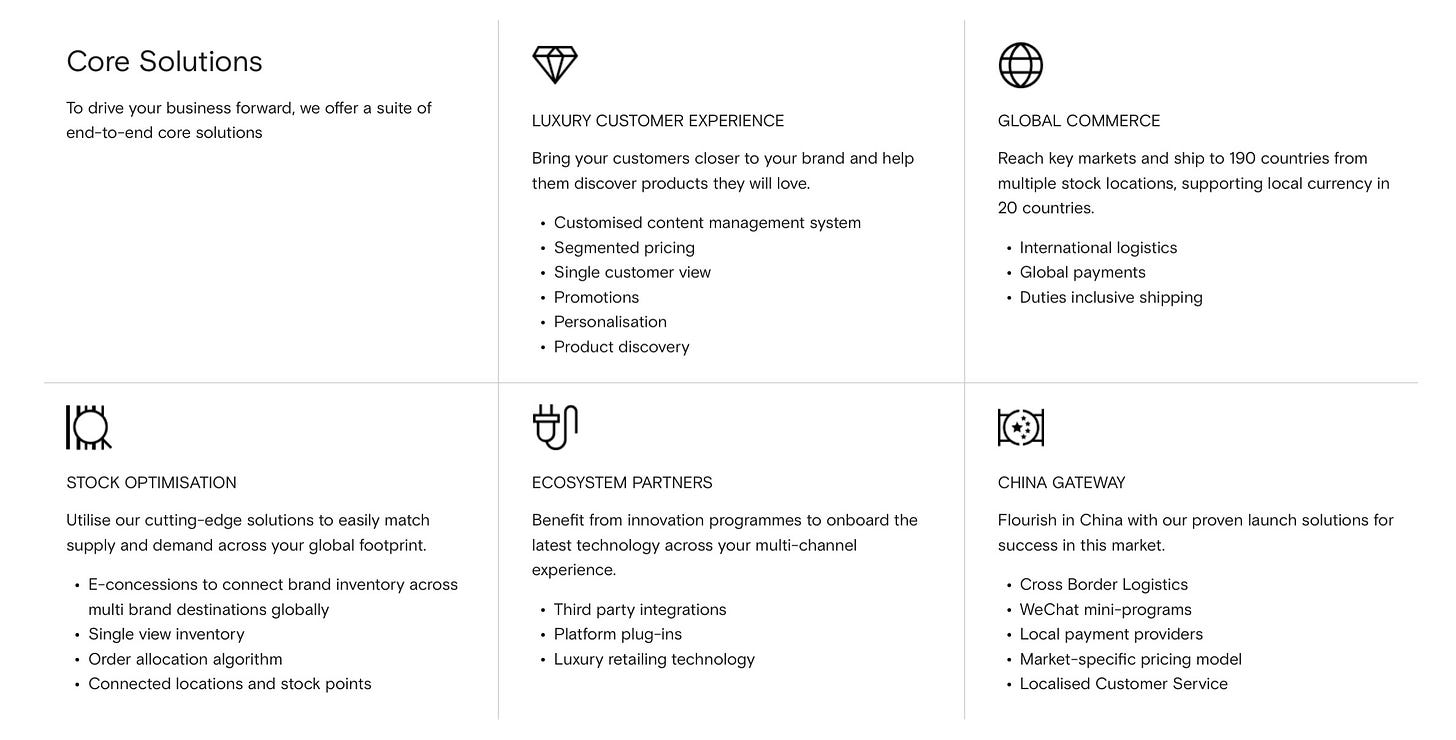
On top of these offerings, Farfetch also offers its customers modular add-ons to tailor their offering even further:
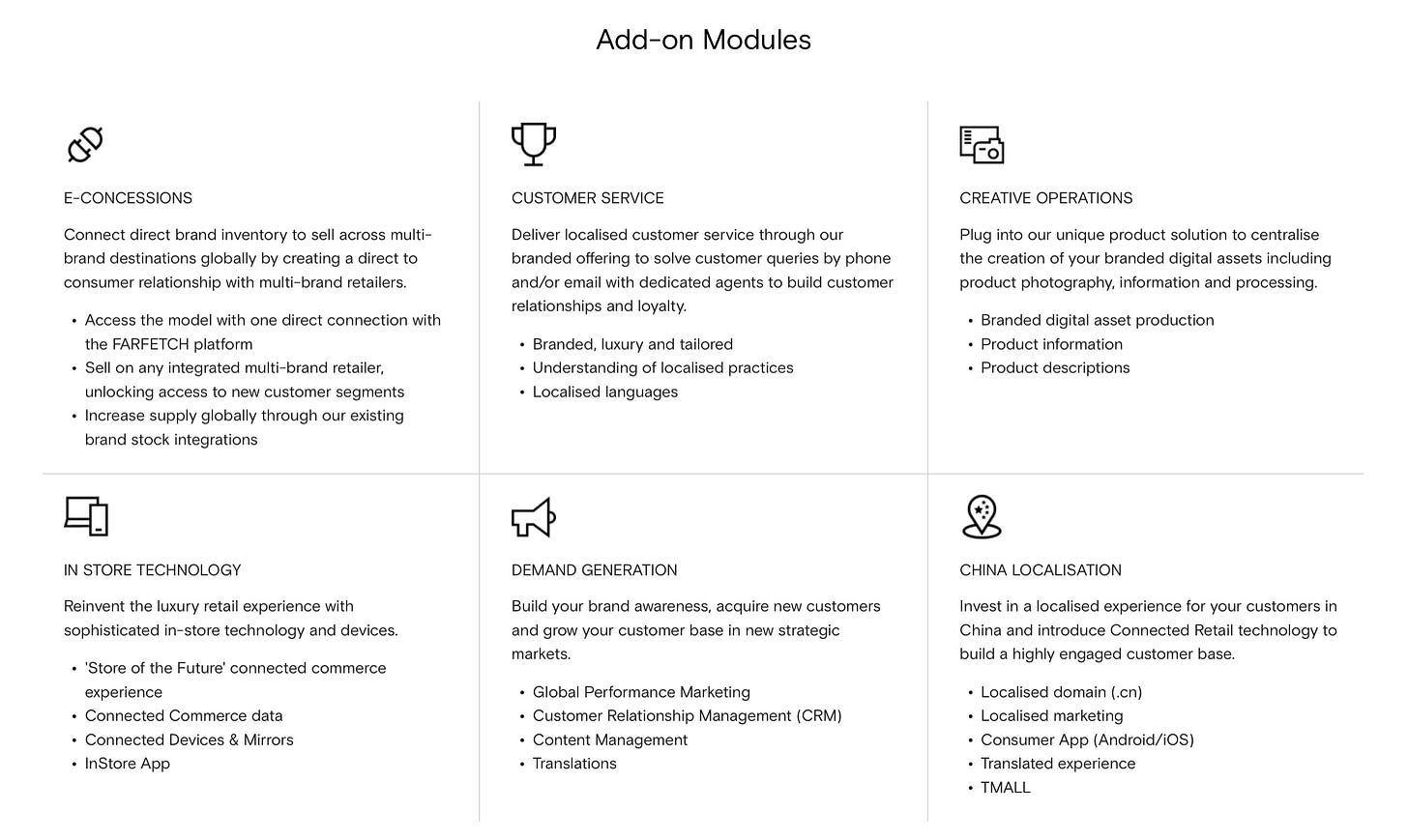
FPS can be directly compared to Shopify’s offering, although it’s obviously geared towards luxury brands and offers a significant advantage for this type of customers: Chinese expertise. Considering that China is expected to become the largest luxury market worldwide and the fact that business is done differently there, makes Farfetch’s offering very attractive. It allows luxury brands and retailers to expand quickly and directly across digital channels in this geography. But why should brands trust Farfetch’s China expertise? We’ll talk about this later.
Third-party brands such as Harrods and first-party brands such as Off-White, Browns and Stadium Goods are currently using FPS:
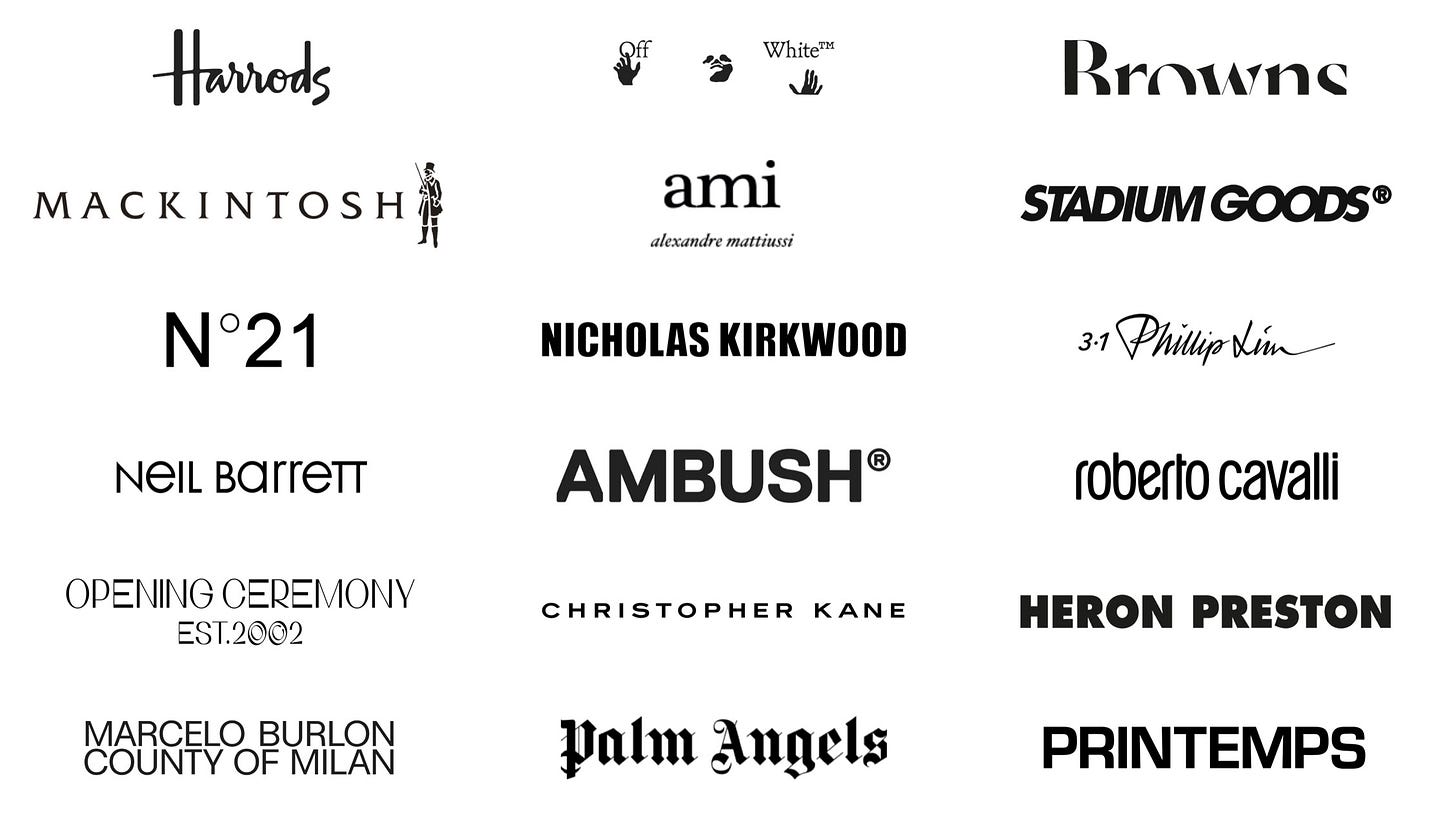
Harrods is the biggest customer using FPS. It became a client in 2020, after the COVID outbreak.
One thing we don’t particularly like about FPS is the fact that the company is not transparent on pricing. This means investors have no sure way of knowing how much money this offering is currently generating. We’ll further discuss this in the bear section of this article.
3. Farfetch Store of the Future
Here is where things start to get a little bit futuristic. Most of you might already be familiar with the word Metaverse, especially since many of the big tech’s CEOs have been talking about it lately.
For those of you who might not know what the metaverse is, or better said, what it is expected to be, in Invesquotes’ Unity Deep Dive, there is a full section dedicated to the metaverse and this is the definition that most resonates with us:
The metaverse is seen as the natural successor of the World Wide Web (internet). In its full aspiration, the metaverse is expected to be the gateway for most digital experiences and a key component of the physical world.
Although many people think that the metaverse is just a fully-virtual world, we see it in a different way. For us, the metaverse is the platform that will allow users to transition seamlessly from physical to digital worlds. In no way the metaverse aims to exclude the physical world by making a full transition to virtual.
Farfetch’s Store of the Future is basically the company’s metaversque offering. It’s the retail innovation arm of the company that aims to connect physical and virtual retail luxury experiences. The interesting thing is that it aims to do so both from the demand and supply side.
This initiative started as CEO José Neves wanted to answer the following question:
How will people shop for luxury fashion in five or ten years?
There are a wide range of initiatives under the store of the future but all of them follow the same goal of a seamless transition from physical to virtual and vice versa. It’s important to note that Farfetch’s vision has never been oriented towards helping luxury brands transition to a full e-commerce model:
While the proportion of luxury sales through e-commerce continues to increase, physical retail remains a crucial part of the sales journey for the luxury customer.
Source: Farfetch 10K
Management knows that physical stores are very important, especially in the luxury industry as customers want to retain the experience of going to luxury stores. You have to think that, many luxury customers buy luxury as a way of demonstrating a high social status or for the experience overall. So being seen in one of these stores is a great way of achieving this goal. Like we said before, over 60% of customers still prefer to buy high luxury in a store.
The Store of the Future might be difficult to imagine but Farfetch recently launched several Store of the Future initiatives in a Brown’s store in London that can help you get a grasp of some of the features the company is working on:
The company is not alone in this venture as, in 2018, it signed a multi-year global innovation partnership with Chanel. Even though this venture is in its very early days, it looks very promising as Farfetch will also start launching some of these features in some of Channel’s stores in Paris.
Features of store of the future will also be seen in the Cidade Matarazzo project in São Paulo:
Appointed by Cidade Matarazzo complex in development in Sao Paolo, to implement our Connected Retail solution to create a technologically advanced luxury experience across the complex’s entire 300,000 square foot retail village
FPS and Farfetch Store of the Future are two key components of Luxury New Retail, the company’s long term vision which we’ll go over shortly.
Farfetch has also made a series of acquisitions to further strengthen its competitive position. These acquisitions comprise the last 3 business lines of the company.
4. Browns
Browns is a British fashion and luxury goods retailer which was acquired by Farfetch in 2015. The acquisition was strategic as Farfetch wanted to shift to an omni-channel growth strategy and was lacking physical stores.
Browns, alongside the other acquisitions, allows Farfetch to carry out two objectives:
Understand the fashion industry from the eyes of physical retailers and boutiques
Implement and test the features developed under the store of the future
Browns currently operates two stores in London and also offers the possibility to shop their products online, both on its own website (built with FPS) and The Farfetch marketplace:
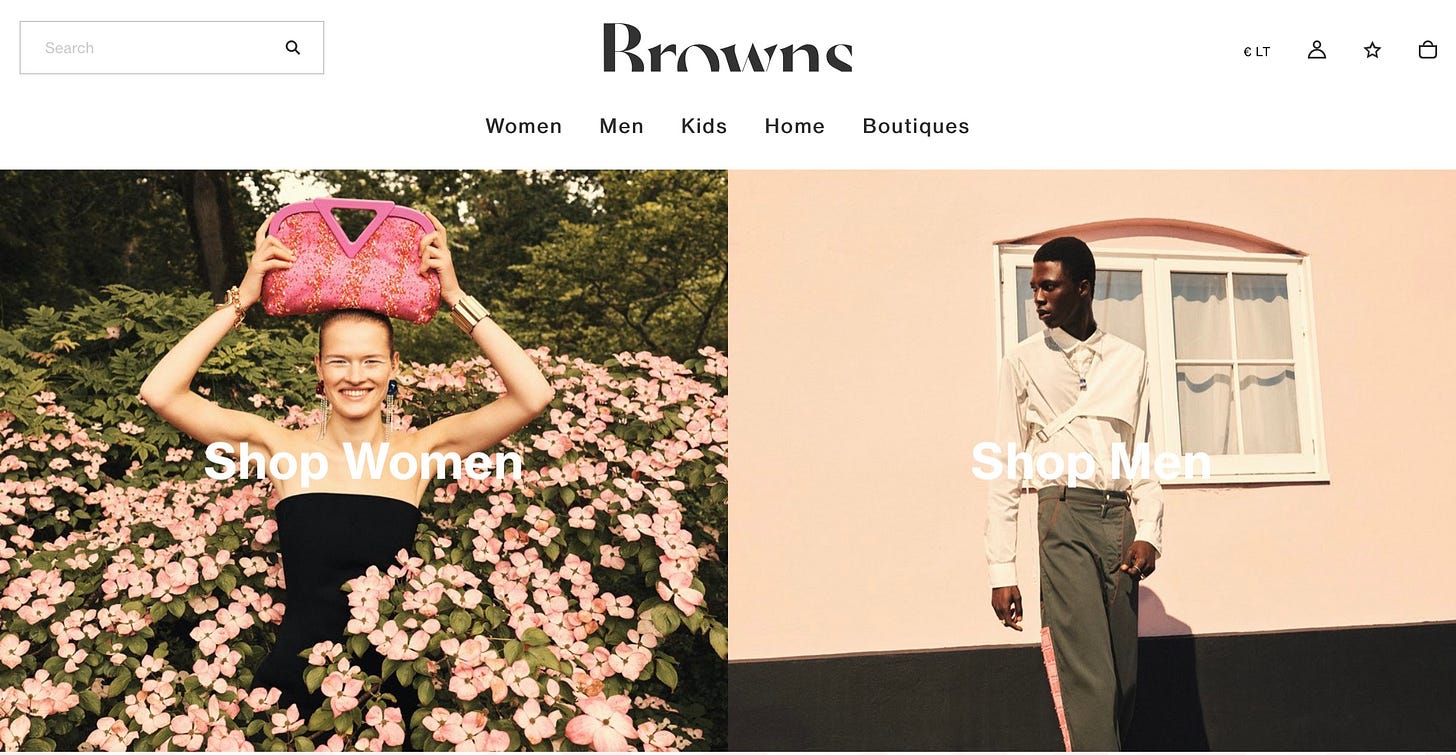
5. Stadium Goods
Stadium Goods is a premium sneaker and streetwear marketplace that Farfetch acquired in 2018 for $250 million. Here you can buy new and second-hand (but never before worn) products so it also has the resale touch to it.
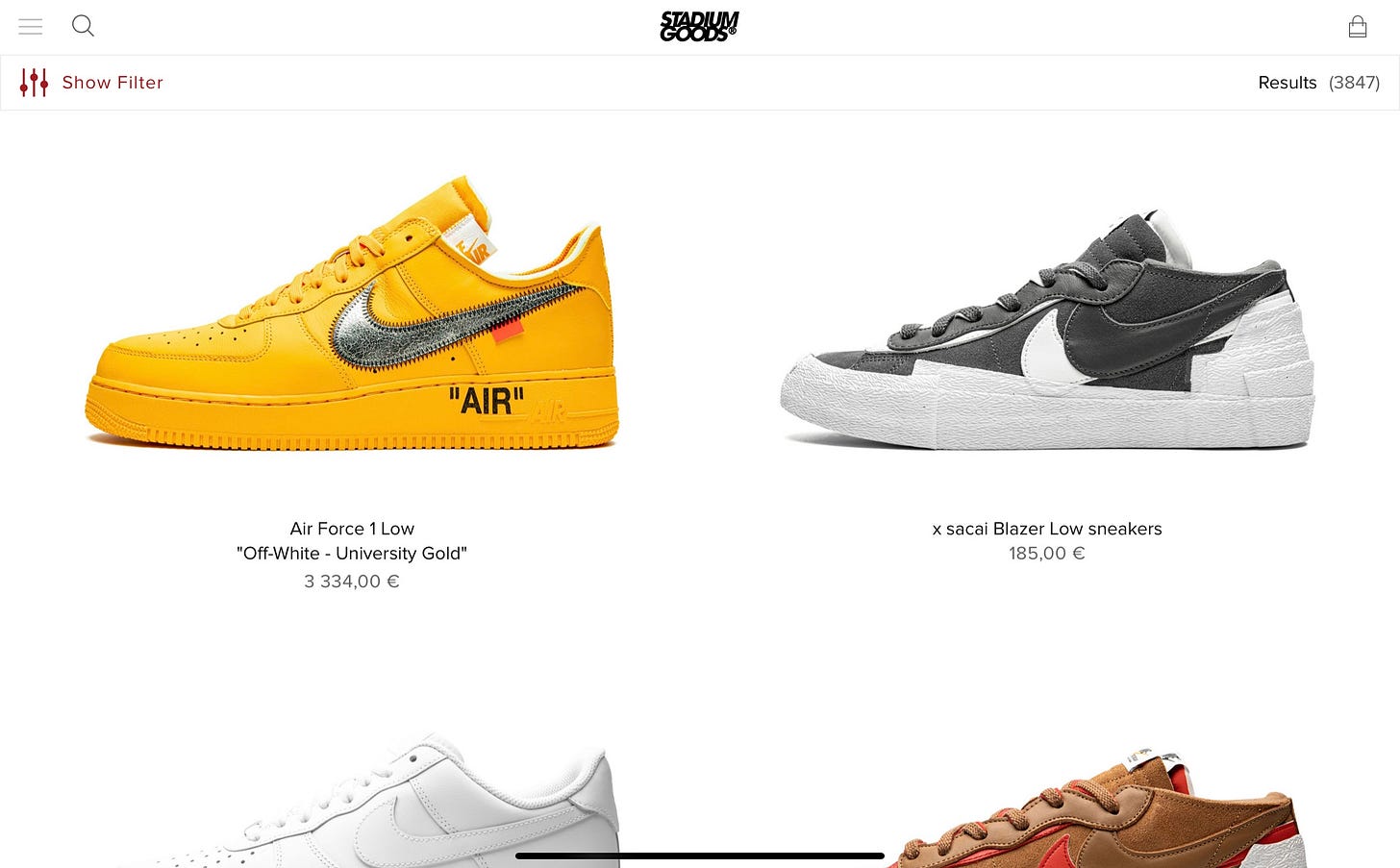
Stadium Goods’ products can be bought from three main sources:
StadiumGoods.com: powered by Farfetch Platform Solutions
The Farfetch Marketplace
Other marketplaces such as Alibaba and Amazon
Sneaker resale is a rapidly growing industry which accelerated significantly during the COVID pandemic. According to Cowen:
Our estimates of third party data and interviews with channel participants suggest the sneaker and streetwear resale market is north of $2B in North America, growing by 20%+ y/y with potential to reach $30 billion globally by FY30E.
33% of 18-24 year olds and 33% of 25-34 year olds have purchased from resale sites in the past 30 days – up from 26% and 28% last year. This implies 20%+ growth in active users y/y.
Not only is sneaker shopping growing rapidly, it also enjoys a great amount of “free” marketing on platforms such as Youtube. In this video you can see Billie Eilish going sneaker shopping at the Stadium Goods’ store in NY:
This video currently has 26 million views and Billie Eilish spends $2,400.
6. New Guards
In 2019, Farfetch acquired brand platform New Guards for $675 million. New Guards Group (NGG) is oriented towards supporting the best creative talent in the world and building iconic brands.
It currently owns and operates, among others, the following 9 well-known brands:
With this acquisition, Farfetch also added a brand approach which is the last layer it needed to add to its already existent technology, data and logistics platform. This acquisition will allow Farfetch to incubate emerging brands thanks to this new brand expertise and its existing ecosystem.
The company is already starting to experiment with this formula as, later this quarter, the company will launch “There was one”, the first combined brand between Farfetch and New Guards that will be exclusively offered across Farfetch’s channels.
Exclusivity is another obvious opportunity of owning these brands because Farfetch is able to drive organic growth into its digital platforms as customers will have no other choice if they want to purchase products from these brands.
With this, we get to the end of the overview of the company’s business lines and now it’s time to see how they are grouped under the different operating segments. The company currently reports three distinct operating segments, with revenue being distributed as follows between them during the most recent full year (2020):
1. Digital Platform segment
The Digital Platform segment includes the Farfetch Marketplace, Farfetch Platform Solutions, Farfetch Store of the Future and the digital marketplaces of Browns, Stadium Goods and brands in the New Guards portfolio. The company makes a distinction between services revenue and fulfillment revenue in this segment. Fulfillment revenue is the revenue generated to cover the costs of the logistics solutions where Farfetch basically makes no profit. We’ll see later on how Farfetch eliminates this type of revenue to calculate adjusted revenue.
Even though 3P sales still make the majority of digital platform services revenue, 1P sales are growing 3x as fast which makes total sense considering that Farfetch is increasingly selling its acquisitions’ products through its digital channels.
One would think that post COVID, Digital Platform revenue as a percentage of total revenue would increase but this is far from true, it actually decreased primarily due to the acquisition of New Guards in 2019 which makes year over year comparisons misleading.
2. Brand Platform segment
Includes design, production, brand development and wholesale distribution of brands owned by New Guards. Franchised stores are also included in this segment. This segment grew 137.5% Y/Y mainly due to the inclusion of the full year revenue of New Guards which did not contribute to the full year 2019.
3. In-Store segment
Includes the physical stores of Browns, Stadium Goods and certain brands in the NG portfolio (those that are not franchised).
I think all of this might seem a bit confusing so we decided to map it out in a simple graph:
Source: Own elaboration
Basically, all of the business lines participate in some way to Digital Platform sales. New Guards is the only contributor to the Brand Platform Segment and the three acquisitions participate in In-Store revenue through their physical stores.
Throughout our research we read lots of info and listened to a bunch of podcasts, some of which were directly produced by Farfetch. In these podcasts, we were surprised to see how the private client segment was mentioned many times so, even though it is not considered a business line by itself, we decided to do a brief section talking about it.
Private Client
The private client segment is very important for FarFetch, not only due to the nature of the luxury business but also because it represents a significant portion of revenue. During 2020, the top 1% customers generated 27.2% of the revenue of the company. This customer segment is currently growing “significantly” faster than the overall marketplace:
In Q2, GMV from private clients grew significantly faster than the marketplace and private clients delivered a higher full price mix as compared to other ACCESS tier. - José Neves (CEO)
Source: Q2 Earnings Call
This segment is not something reserved to “elite” customers, in fact, it’s just one of the levels included in the company’s Loyalty Program: Access. This program has 5 different tiers where Private Client is the top tier:

Customers can upgrade by spending more on the platform within a year but they can also be downgraded if they don’t meet the minimum spending for any particular tier. To upgrade to Private Client, customers need to spend a whooping $12,000 annually! As you might already have imagined, customers enjoy better and more extensive rewards as they upgrade through the tiers. Private Clients have access to the following:

From the list of rewards above we would highlight the relationship between personal styling and fashion concierge as this relationship creates a unique offering in the market. Private Clients have access to a personal stylist (the company currently employs around 146 personal stylists) which in turn have access to fashion concierge services. These services allow stylists to access merchandise that is not offered in the Farfetch Marketplace.
Private Clients can basically ask for whatever they want and Farfetch will try to make it a reality. When we say, “whatever they want”, we really mean it:
We had one request not that long ago, soon after global lockdown had taken place and clients were looking for things that could make their time spent at home more enjoyable. We had a request come in from a customer that was looking for a collectors item Nintendo system that was made back in the 90s, and it was a limited edition Nintendo Zelda with only one thousand units produced and he asked us to find one of these, factory sealed, never used. The fashion concierge service hunted it down in Japan and the customer was surprised that we were able to deliver it. - Jamie Freed (VP, Farfetch Private Client)
Source:
This is in fact, one of the offerings among others, that help differentiate Farfetch from its competition. Other e-commerce companies that want to go into luxury are going to have a hard time offering something similar and convincing Farfetch’s private clients of switching.
Farfetch’s offering is truly compelling but the question should be: what does the company aim to achieve with this wide offering? The answer is: Luxury New Retail.
Luxury New Retail (LNR) - Farfetch’s vision of the future
With the pandemic, mostly all of retail was forced to move online and luxury was no exception. According to Bain, despite the luxury industry being expected to grow at a 5% CAGR over the next 5 years, the online penetration of luxury sales is expected to grow at an outstanding 23% CAGR:
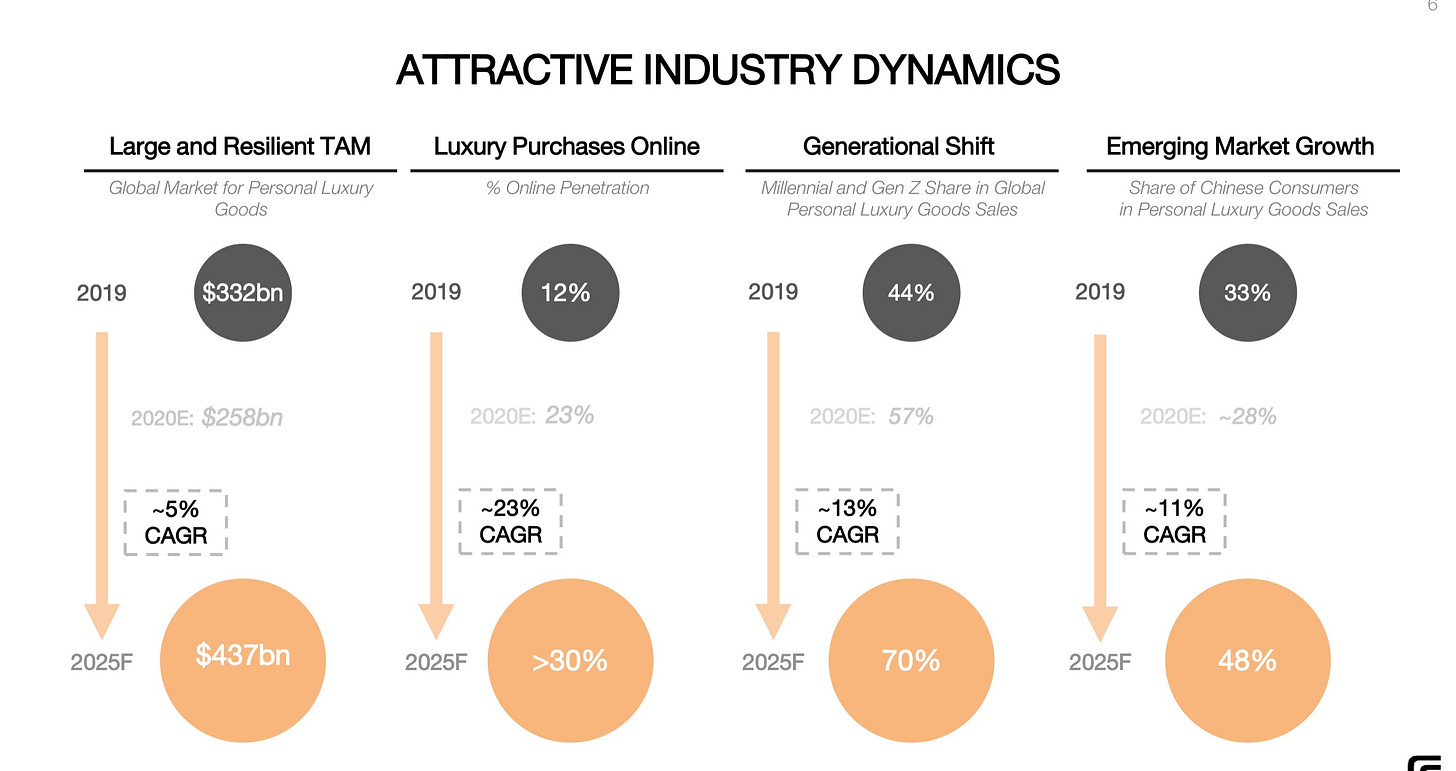
This looks as a promising opportunity for the company as it evidences an expanding TAM. Obviously the online penetration of the luxury industry is expected to lag that of the rest of retail because they are completely different industries and especially the luxury industry has several particularities. As we previously mentioned, one of these particularities is the fact that luxury consumers want to enjoy the experience of buying in physical stores:
While the proportion of luxury sales through e-commerce continues to increase, physical retail remains a crucial part of the sales journey for the luxury customer.
Source: 10K
So now the question is…how does Farfetch plan to take advantage of the increase in online penetration without ignoring the physical channel? Is it possible to find an equilibrium between both channels? We should be able to predict the future to answer this question but what we can say with certainty is that the company is working on it.
The 6 business lines discussed above can operate perfectly as standalone entities but the reality is that they all play a role in the company’s broader vision of Luxury New Retail (LNR). You may be wondering…what is LNR exactly and what does it aim to do?
LNR aims to reimagine the luxury retail experience by working on a seamless integration between the physical and the digital retail worlds. Both luxury brands and their customers will be able to benefit from it:
Luxury brands will be able to have an integrated data set with the preferences of their customers. The source of this data set will be both physical and digital interactions
Customers will be able to transition seamlessly from digital to physical retail and vice versa
We previously showed a video of the Browns’ Store of the Future and that is exactly how Farfetch plans to execute on this vision. How do the different business lines play a role in the future of retail? We have prepared this simple graph to illustrate it:
Luxury New Retail lies as an intersection between physical digital retail and it’s through the store of the future where the company tests its innovations to tie both of these worlds together. Integrating customer experience is key but this can’t be done without having an integrated backend and integrated logistics which is what FPS aims to solve for luxury brands.
Let’s try to explain it with a simple example. You go to a store and you pick up several clothes you want to try on. As soon as you pick them up, they go directly into your shopping cart in the app or they appear in the digital mirror inside the fitting room. Once you have tried these clothes on, you have three options:
You can purchase them directly in the physical store
You can directly purchase through the digital mirror or the app directly and get them send to your house
You can purchase it through the digital mirror or the app and take them with you
Sounds great right? It is, but achieving this is not that simple, especially for brands that lack the digital aspect and the technology to connect both worlds. This is exactly why Farfetch is a great solution for these brands/boutiques.
FPS and The Store of the Future are two important pillars to execute on LNR but it really wouldn’t be possible to put all of the innovation in practice if Farfetch did not own physical stores such as Browns, Stadium Goods and New Guards portfolio brands stores to try these features out. As we saw previously, LNR is also being tested in full force in several Chanel stores.
In the words of José Neves:
Luxury New Retail is not a specific technology product or solution, it’s the division and also the full suite of solutions that we can offer brands that are completely connected. Because everything we offer brands is completely integrated and connected.
3. CHINA: MUCH POTENTIAL AND MANY RISKS
China is positioned to be the most important player in the luxury industry for the next decade and, due to this, Farfetch’s bull and bear case run through this geography. As already stated in this article, 90% of the annual luxury goods transactions growth comes from China and this trend is not expected to slow down anytime soon. By 2025, a whooping 45% of total luxury sales will be done by Chinese customers.
The reason for this astonishing growth lies in the growth of disposable income that the Chinese population will enjoy in the coming years. As you can read in B&H JD Deep Dive released last month, disposable income in China will likely double over the next decade and its middle class will soon represent 79% of the total Chinese population.
These numbers have created a FOMO feeling for brands desperate to penetrate China, and the big players saw this trend early on. One of these early birds was LVMH which saw 40% of its sales growth coming from China, according to its most recent Earnings Report.
The race for the Chinese market was something that Neves and FarFetch entered in 2017, focusing on giving international brands access to Chinese consumers. Starting with basic operations only, they struggled with traffic. This made Neves realise that the entry barrier for foreigners is absurdly high in China, especially due to the retail e-commerce market being heavily concentrated. So, as a solution, FarFetch decided to play by the Chinese playbook and started a new strategy: Partnerships.
The first partnership was with e-commerce giant JD.com. JD invested in Farfetch and gave them exclusive traffic and an inside store on its marketplace. The traffic problems quickly went away and the company started to thrive…but Neves had bolder plans for Farfetch.
After meeting with Joe Tsai in 2019 and after a lot of paperwork, Farfetch resigned its partnership with JD and struck one of the biggest partnerships in luxury’s history, joining forces with Alibaba and Richemont (ironically, Richemont owns one of Farfetch’s main competitors, Yoox Net-a-porter). Alibaba and Richemont invested directly in Farfetch while also acquiring 25% of a newly formed Joint Venture, Farfetch China. This operation ended up with both companies investing $1.1B combined, $600 million ($300 million each) in Farfetch november 2020 convertible notes and $500 million ($250 million each) in a newly created Farfetch China for a 25% stake each. The following drawing should help you make sense of these words:
Besides the partnership, Farfetch migrated from JD to Alibaba’s high end marketplace, Tmall. The change made headlines when Farfetch announced it saw record traffic coming from China after only one quarter at Ali’s reign.
All was going well, and this section would be quite a pitch for a bullish case on Farfetch, if it weren’t for the recent events coming from China. As most of you know, the Chinese government started a heavier season of regulations, one that shows signs of not going away for quite some time. That brings two problems for Farfetch:
The regulation coming hard at Alibaba
The regulation that may eventually come to the luxury industry
On the regulatory issues with Ali, the path is far from clear. Anyone who claims to know how and when it will stop is lying. This might or might not compromise Alibaba's position as the e-commerce leader in the future, but that will only be known in due time.
Bottom line is, Farfetch might suffer from a traffic stagnation if the worst case happens, but up to now, something drastic has yet to materialize. Alibaba’s last ER shows exactly that, as they added more users, now reaching almost 1 billion across all marketplaces (to see B&H Earnings Digest on Alibaba click here).
On the second point we have the most troublesome possibility. As seen in the most recent 5 Year Plan from the Chinese government, consumerist behavior is something that is and will continue being opposed by the government.
The CCP wants to shorten the gap between classes in China, and it wants to do that without any promotion of capital accumulation. Knowing that, we don't need to tell you that spending thousands of dollars in purses and shoes is not exactly amongst the goals of the CCP.
As of right now there are no indications of direct measures against luxury. That said, to invest in China one must work with subtle hints and probabilities, even if luxury companies aren't kicked out of China, Facebook style, there is a high chance that the spending towards fashion and luxury will be discouraged at some point in the next decade, especially with the growth we are seeing in China’s consumption.
We’ll further tackle the Risk/Reward relation of operating in China in the Bull and Bear Case sections.
4. BEAUTY: POTENTIAL WAITING TO BE UNLOCKED
Arguably one of the most exciting projects from Farfetch for the future is their entry to the beauty sector. Although it is still only a small section of the app and site, management already stated that it will be fully launched in 2022 and this launch can be a game changer if executed right.
According to a Mckinsey study beauty is one of the most resilient products on a global scale. However, with more than $500 billion in sales, representing 30% of all luxury and apparel luxury has been changing.
The cosmetics industry is historically a defensive one regarding e-commerce. Gen Z especially is turning the tide, as we can see on the image below, extracted from the same McKinsey study:
That shift to buy beauty online will probably only increase as time goes by, and Farfetch is well positioned to tackle this change like no one else. The company’s built marketplace for exclusivity and high end experiences can probably integrate easily with LNR. Imagine: you try out some makeup on the physical store, buy on the Farfetch app while inside the shop and get it delivered to your home, making the following purchases directly in the app.
That huge industry's potential is still untapped. Due to the lack of competitors at the scale of Farfetch and the shown difficulty of players like Amazon, beauty should go into the “watch closely'' section for any Farfetch bull or bear.
If you are liking this article, consider subscribing!
5. MANAGEMENT QUALITY AND CULTURE
If this is not the first deep dive you read of The Global Investor, you already should know that we consider management one of the key pillars of growth companies. When companies are so early into their growth, a great management team is a must because the company will probably be in the process of allocating capital into growth opportunities to build its long term moat. Who decides where this capital is going? Management does.
Farfetch has a large management team which is currently comprised of 17 executives:
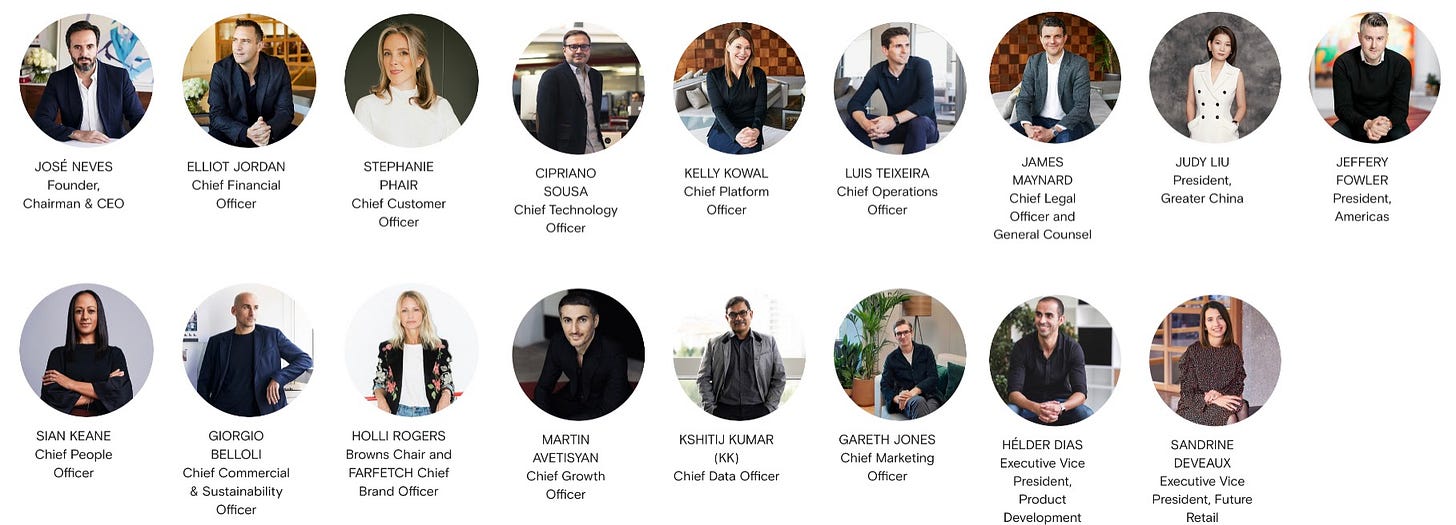
Although we would obviously love to talk about all of them, we consider that our readers’ time is very valuable. For this reason, we will talk in this section about who we consider are the key managers of the company: José Neves, Stephanie Phair, Cipriano Sousa and Judy Liu.
The fact that we are talking just about these managers does not mean that we consider the rest to be bad managers, it just means that we needed to choose 4 and we went with what we consider the outsiders of the group. We must say, these 4 managers did not dissapoint.
To kick things off, we’ll start with José, the founder, CEO and visionary of the company.
José Neves
José Neves is the founding base and the mastermind behind Farfetch and there’s not that much more we can say about the CEO and Chairman. The Buddhist (by philosophy but not religion, as he says) is nothing short of a visionary, as the history section already evidenced. Neves has to be more than just a cerebral executive to thrive in the fashion world, and he is well aware of this:
Fashion is cultural and especially personal.
To get ahead of the curve and convince boutiques run by generations of the same family throughout time, he had and still has to be a soft skills master and a sensible executive. An article written by an early investor in Farfetch shows us how José is simply laser focused on people:
In our early due diligence 9 years ago, it was clear that the early adopters in the industry had joined the Farfetch platform because of their relationship with José. In fashion, many companies are family-owned (from multi-brand boutiques to department stores to even the largest luxury groups), many decisions are based on trust, relationships, and emotion. This is something José has worked tirelessly on, building trust with key partners and winning over their support over time.
That altruism and logical analysis combined with a technical ability built the leader that José Neves is today.. As we’ll see down below, José has a 97% CEO approval rating on GlassDoor, a mark that only confirms what Carmen Busquets, another early investor in Farfetch and its competitor Net A Porter thinks about the founder:
In my 30 years of experience, I have not come across another founder like him. It requires you to remove your ego from the picture to have that kind of success. Neves’ knack for building bridges rather than burning them facilitated something that has never existed in the history of retail. He knows how to be friendly, which is something that very few of us in the fashion industry are capable of. I think it can be bigger than LVMH and Kering. No one else at the moment understands the luxury industry better than José.
Although it is too early to tell, José Neves may prove to be a generational talent. If you are studying Farfetch as a potential investment you should study Neves very closely because he holds voting control in the company so you would basically be investing in his vision and decision making skills. He is the only holder of the 43 million class B shares which grant 20 votes each, this makes him have +70% of the voting power of the company.
It’s also important to take into account that all of these 43 million shares are convertible to class A shares anytime which would give José considerable skin in the game. If we join his class A and B equity tenure, the Founder has about a $2 billion stake which is very significant.
Stephanie Phair
Stephanie is currently the Chief Customer Officer at Farfetch, a role which she has served for two years. Previously, she served as the Chief Strategy Officer for two years but this position eventually “disappeared” and is now embedded in her current role.
Even though the role of Chief Customer Officer might sound very generic at first glance, it’s a really important role to execute on the company’s long-term vision. Stephanie is responsible for leading the company’s consumer-oriented functions which include business lines such as the Private Client business and the Luxury New Retail strategy. We like how she explains Farfetch’s vision in this interview:
In merging online and offline, we are putting the customer at the center, and giving them an amazing retail experience. It is a data-play, and it’s fascinating where that’s going. I think another key is that it’s not just about data. Farfetch has always understood that it needs to merge both art and science, to be great at human connection and storytelling.
Customer centricity is a must for any company, more so if it’s dedicated to luxury.
She fits almost perfectly in a company such as Farfetch as she has more than 20 years of experience in luxury and e-commerce which is exactly the industry where the company currently operates. In fact, in 2009, Stephanie founded a company somewhat similar to Farfetch, Outnet.com, where she was responsible for the growth strategy. Not only is Stephanie a good leader, she is also a visionary and saw the potential in China early on as evidenced by this recommendation that can be read in her LinkedIn profile:
I had the pleasure of working with Stephanie at THE OUTNET. Stephanie is an inspiring leader, a visionary and a trusted thought partner. I admire her collaborative leadership style and ability to rally an organization around her vision. From launching a private label, to being first to market in China, Stephanie's business expertise is always evident.
Her responsibilities are not limited to Farfetch as she has deep roots in the fashion industry serving as the (youngest ever) Chairman of the British Fashion council, independent Board Director of Moncler and Advisor at Felix Capital, a venture firm focused on digital lifestyle.
She currently has a 0.2% stake in the company which currently amounts to about a $28 million stake. Not too high but not bad either.
Cipriano Sousa
Cipriano did not found Farfetch per se but he is the first employee of the company and has always been Neves’ right hand man. He studied Electrical and Computer Engineering in the University of Porto where he met José, an event that marked the beginning of a great relationship, both personally and professionally.
José Neves clearly trusts Cipriano’s knowledge as he was the first person he called when he had the idea to start Farfetch. Cipriano, on his side, has a deep admiration for José Neves:
José remains as revolutionary as he was then (when José started Farfetch), but with much more wisdom, more serenity, more focus.
As CTO he has been key in what the company is today as it was a team under his leadership who created the first version of the Farfetch Marketplace:
I was the one who wrote the first line of code of Farfetch.
He currently oversees the tech team in matters such as software development, security, business intelligence, R&D, user interfaces, mobile...By now it should be pretty clear that this is a very important role inside the company as Farfetch is more of a tech company than an e-commerce company.
Cipriano, however, has not only been important in the company’s past developments as he has also helped Farfetch shape its tech culture which will be key to achieve all of the future milestones of the company:
We started as a small startup, and now we are a decade old, but I want to keep our startup environment. Therefore, we organised F-Tech in domains, and each domain has a particular mission towards Farfetch, Product and Technology wise. Domains contain clusters, and we split each cluster into teams. My goal is that each cluster works like a startup, which means that if a cluster wants to choose a specific programming language or tool, they are free to do it. This is because we want to have autonomous groups to keep being agile and fast because it guarantees we continue developing.
Judy Liu
We could not leave Judy Liu out of the management section, since as we explained, China is a super important part of Farfetch’s business. Judy is the President of Greater China Operations, and her resume couldn’t suit the role better.
Judy Liu started as an executive officer but soon turned into an entrepreneur. The Chinese President was in love with fashion since a young age:
I like the Internet and technology, but fashion is my natural passion. I have loved fashion ever since I was a young girl. I come from a very traditional Chinese family; a lot of my family work in taxes. I almost followed their footsteps. But the more I grew up, the clearer I realized where my true passion rested. I joined an Internet start-up company, and, later, became an entrepreneur.
Following Jose's footsteps (without even knowing him), she then founded Curiosity China, a startup that combined tech and fashion to provide digital solutions to international brands that wanted to access the Chinese population. The startup was growing fast and this caught Farfetch’s attention. Farfetch acquired Curiosity in 2018 and made Judy Head of China.
Her understanding of the local economy justifies the excitement for the future of chinese luxury:
I think it’s a very exciting time for luxury. Global offline retail business still represents 90% of the market share. Online there is more importance, not only on the conversion power (25% of luxury sales will be online by 2025) but also on the purchasing decision (Social media is now the Top 1 influence to lead to purchase). Luxury brands see China as the present and future of the industry.
The young executive is also a born leader, something crucial to navigate a market that is so closed and difficult to understand:
I think a leader requires confidence for sure. Everyone's looking for a leader who can inspire and guide them. To be a people leader requires experience and confidence, as well as trust with your team. I am a people person; I am always trying to bring a positive revolution in our teams by sharing our common values. I spend as much time together with my team as possible. Leadership is about growing your team, helping them go to the next level.
Culture
We found management to be exceptional overall but these key managers graduated with honors in our quality standards. The feeling we have is as if these managers were born to work in a project like Farfetch which is obviously something you love to see in any management team.
Now that we have seen what the key managers are responsible for at Farfetch, it’s time to look at another important characteristic when assessing a company: its culture. Farfetch is a company that is very worried about the wellbeing of its employees and attributes most of its success to its culture. In the words of Stephanie Phair:
I think we owe our success mainly to our company culture, and to the fact that we have hired people who are problem-solving and problem-seeking engineers, basically....Farfetch is a humble company. It never takes success for granted. If you look at the people who work there, everyone just wants to do better. That comes from José and the executive team. You couldn’t ask to work with better people.
This interest in taking care of the culture at Farfetch is directly translated into positive reviews on GlassDoor:

In the reviews, several things stand out. As highlights we see that many people talk very positively about the culture and atmosphere at Farfetch, including those who end up leaving a negative review:
“Excellent colleagues, good offices and brand”
“Farfetch is full of great people who really live the values of the company.”
“The atmosphere is really good.”
“The culture and people are incredible.”
On the other side, most of the negative comments make reference to low salaries, the absence of opportunity for lower levels and, surprisingly, low headcount efficiency:
“The salary and career path are not very balanced.”
“Salaries are quite low.”
“The salary is the worst.”
“Lack of development opportunities for lower levels.”
“Sometimes there are times where there is not much work.”
“Much work overlaps between teams.”
These reviews help us see that even though the company seems to have a great culture it also has problems that it might need to tackle to be successful over the long term. Low salaries in the tech industry are not ideal because competition for talent is intense.
Compensation
One of the most important things when researching management is determining if the executives are fairly paid or money driven.
Farfetch excells at this point in our opinion. According to the latest 10K, compensation consists of base salary, an annual incentive tied to achievement of Company and individual performance, contractual benefits, and pension contributions.
The total cash compensation paid and benefits provided to each of the the executive officers and members of the Board of Directors was $1,714,761. We’ve seen much worse out there (looking at you Snowflake).
The interesting thing in this point is - then again - José Neves. The founder did not only fully renounce his base salary and annual bonus but coupled up his stock compensation to the stock performance for the next 8 years, starting in 3 years from now.
As we can see down below, Neves needs the stock to be at $250 dollars by 2028 (a 6x from today’s prices) so he can fully receive his compensation.
In normal conditions we would dislike this measure since it makes the CEO focus on the price and not on the business. However, knowing Neves and the long term conditions of this compensation, it is safe to say this is positive for shareholders.
6. NUMBERS AND FINANCIALS
In this section of the article we’ll go through the key numbers and the financials of the company.
Gross Merchandise Value, Take Rate and Revenue
We decided to talk about GMV, Take Rate and Revenue in the same subsection because these items hold a very close relationship between them.
As we have already mentioned, the company does not generate all of GMV as revenue because in many cases it acts as an intermediary between buyers and sellers (3P model), only allocating the take rate from these transactions as revenue. On the other hand, in those transactions where Farfetch sells its own products, the GMV is fully recorded as revenue. In the following graph you can see the relationship between GMV, take rates and revenue:
This graph might lead you to think that FarFetch’s revenue must be somewhat similar to GMV because 2/3 of the items from GMV have a 100% drop through to revenue but in reality, 3P platform GMV currently makes up for the majority of GMV and this is not expected to change over the long term:
So 5-10% of our overall GMV short-term is probably where you can expect 1P business over the longer term that's going moderate back to 5% overall and the growth rates will turn back in line with the overall growth rates of the platform. - Elliot Jordan (CFO)
Source: 2018Q3 Earnings Call
If you are still having trouble understanding the relationship between these variables, think about it this way…
GMV is the total value of the transactions in the platform between buyers and sellers
Take rate is what Farfetch is keeping from these transactions due to the services it provides to match buyers and sellers
Revenue is simply these two values multiplied which is what the company is making in these transactions
Take into account that in the example above, we showed an example with The Farfetch Marketplace but business lines such as stores also generate GMV with a 100% drop through to revenue.
After this brief explanation of the relationship between GMV, take rates and revenue it’s time to look at these three metrics, their evolution and where we can expect them to trend going forward.
Gross Merchandise Value (GMV)
Gross Merchandise Value is one of the key metrics of the company as it shows at first glance the company’s ability to scale. This KPI is moving in the right direction:
As it is evident in the graph, the company exhibits the typical seasonality of any retailer, growing sequentially through the calendar year. Even though the company is facing increasingly tough pandemic comps it has been able to post 60% and 40% growth in the last two quarters.
Almost of all total GMV is being driven by the Digital Platform which was aided by considerable tailwinds during the pandemic:
Take into account that, even though the downside was much lighter, the company also faced headwinds in its store segment due to store closures which mitigated in some way this effect on total GMV. This said, Farfetch has been a steady GMV grower since its foundation and it doesn’t seem to be done at all:
2018 was our 10th consecutive year with more than 50% GMV growth. - Elliot Jordan (CFO)
Source: 2018Q3 Earnings Call
As we will see later on in the bull case section, GMV directly benefits from the two sided network flywheel. As the company continues to scale its marketplace, more buyers and sellers are attracted to it which further boosts the flywheel.
Take rates
We are not interested in 1P, fulfilment and in-store take rates because we know that these are 100% due to the company owning the products. The true value of the marketplace is given by 3P take rate because this KPI measures how much buyers and sellers are “willing to pay” to use the platform.
These take rates tend to suffer when competition kicks in or when the perceived value of the platform by its stakeholders drops. Farfetch’s 3P take rates are impressive and have been this way for quite some time now:
The company has managed to maintain a 30% take rate during the last two years despite having increased competitive pressures. This has been obviously aided by the fact that none of the big players such as Amazon and Shopify have been successful in targeting the high fashion industry niche. Basically, luxury brands and sellers don’t have another place to go if they want to sell at scale which allows the company to maintain these high take rates.
Revenue
Revenue, just as GMV, has also been trending in the right direction. YoY comparisons in total revenue have to be taken with a grain of salt due to the company’s recent acquisition of New Guards:
Total revenue surged in 2019Q3 due to the acquisition of New Guards and dropped steeply in 2020Q3 due to comparative reasons (the company was already comparing with quarters where New Guards was included). Total revenue growth seems to be stabilizing during the last quarters at around 40% which is still quite impressive considering that comps are increasingly getting tougher.
The company also calculates Adjusted Revenue to better measure the performance of the business. Adjusted Revenue is calculated as total revenue minus digital platform fulfilment revenue. The idea behind this calculation is taking out of the equation the revenue that does not provide any economic benefit to the company:
This is really the metric that any investor should be watching closely because this is the revenue that will actually help the company sustain its margins over the long term. Adjusted revenue follows a similar trend than total revenue and growth rates have stabilized around 40% for the las two quarters too which, again, is quite impressive.
If we take a look, more specifically, at Digital Platform Services revenue evolution, the picture is more stable as most of New Guards revenue is generated through physical retail. We can see that the pandemic clearly aided this segment:
Don’t forget that even though the company has three distinct operating segments, Digital Platform is the one that contributed the most to revenue (75%). It’s also of utmost important to monitor it going forward as two of the business lines (Platform Solutions and Store of the Future) with the most potential are included in it.
The company is facing increasingly tougher comps, especially in the Digital Platform segment which surged during the pandemic but it’s being able to maintain high revenue growth rates regardless. Revenue and more specifically, it’s growth, is a very important driver of long term returns so it always pays off to watch it closely.
Active consumers and average order value
The two-sided network flywheel only works if both buyers and sellers are present in the platform and, although tracking sellers is not so easily done due to the lack of direct reporting, the company does provide a measure of buyers turning up to the marketplace: active consumers.
What is active consumers? Management gives the following definition:
A consumer is deemed to be active if they made a purchase within the last 12-month period, irrespective of cancellations or returns.
Farfetch has nearly 3.4 million current active customers and this metric has also being trending in the right direction:
The pandemic obviously helped this metric as it is evidenced by a steep jump in 2020Q2. We have to be careful with several aspects of this metric while analysing it. Firstly, although not so important, you have to take into account that the big jump of 2019Q1 was caused by management including Browns and Stadium Goods into the metric.
Secondly, and most importantly, this metric should never be viewed in isolation. These consumers are not worth anything if they make small purchases, especially since we are talking about luxury. Farfetch could choose to offer discounts to attract more active customers while lowering the average order value. This, however, does not seem to be the case as Average Order Value (AOV) of these consumers has remained fairly stable during the last three years:
AOV suffered a steep decline during the pandemic due to first time orders:
Our average order value decreased 18% year-on-year to $493, due to the high mix of first time orders, which tend to have lower average order values. - José Neves (CEO)
Source: 2020Q2 Earnings Call
Ignoring this one time event, AOV remains stable especially considering that it’s impacted by currency translation rates.
The company is still not profitable so where is this money going?
Expenses
In this section we’ll be looking at general expenses, ranging from Cost of revenue to Operational Expenses. This is pivotal to assess how sustainable the growth currently is.
Cost of Revenue
Farfetch’s Cost of Revenue increased at a 3 year CAGR of around 70%, while Adjusted Revenue itself increased at a 3 year CAGR of 63%. Although that’s usually not a good sign, Farfetch is in hypergrowth stage, so increasing costs for growth is not an unusual or negative measure, especially seeing that these growth rates are not so far apart.
We can go as far as saying that this is actually a positive relation, although Revenue/Cost of Revenue is slightly decreasing. In 2017, Cost of Revenue represented 47% of total Adjusted Revenue. That number has now increased to 54%. Again, this shouldn’t be any reason to raise alarms, since growth companies usually focus on margins later on their paths. That said, it is heavily advisable that the Cost of Revenue growth remains closely watched by any bull or bear, since the gap might widen to a worrisome level.
OpEx
Operational Expenses are categorized in: Demand Generation Expense; Technology Expense; General and Administrative; Share Based Payments; Depreciation and Amortization; and Others. We’ll tackle the first four, due to them being more important and the other ones not being out of the ordinary.
Demand Generation
Demand Generation is the way Farfetch calls Sales and Marketing. The company describes this expense as the following:
Demand generation expense consists primarily of fees that we pay to various media and affiliate partners.
Farfetch’s Demand Generation Expense increased by an average of 46% in the last two years, less than the revenue. That by itself is already a good sign that the Customer Acquisition is effective and Network Effects are being created. Because of that, S&M as a percentage of Adjusted Revenue has been decreasing steadily, from 19.3% in 2018 to 13.6% in 2020.
As of right now FarFetch seems to have its head on the right place when it comes to marketing expenses. It knows that those have to be increased to ramp up customers, but not in an unsustainable way or for too long. The following quote from the company's last 10K shows that:
We will continue to invest in consumer acquisition and retention while the underlying consumer unit economics and consumer lifetime value indicates the return on investment is strong. We expect these expenses to increase as we continue to grow, alongside search engine marketing expense inflation. However, we expect such expenses to decrease as a percentage of Adjusted Revenue over time as we increase our share of Digital Platform revenue derived from Farfetch Platform Services and first party original Marketplace product, both of which operate at a lower cost to revenue percentage and we improve the efficiency of our demand generation activities and the percentage of our business related to existing consumers increases.
Another metric we can calculate to see how effective the company is in customer acquisition is “Demand Generation Expenses per new active customer”.
In 2019, Farfetch added a total of 714.6K active customers and incurred in $151.3 million of demand generation expense. In 2020, the company added a total of 956K active customers while generating $198.8 million in demand generation expense. This means that the company spent the following amounts in demand generation to acquire each customer:
Farfetch was able to decrease slightly in 2020 the amount of demand generation expense it needs to acquire new customers which was also probably aided by COVID tailwinds. Take into account that, as we saw before, average order value is over $600 dollars which means that, on average, these new customers have spent at least $600 during the last year while the company has only spent $207 to acquire them. This speaks great things about Farfetch’s CAC.
Of course, part of the demand generation expense is aimed at maintaining current active consumers, not only on acquiring new ones.
Technology Expenses
Technology Expenses is what Farfetch calls the good and old R&D (don’t ask us who named those things). The company describes the expense as the following:
Technology expense consists of technology research and of development, staffing costs and other IT costs, including software licensing and hosting.
This expense is obviously pivotal to any tech company. Farfetch grew it by around 30% in the last two years. As a comparison let’s take a look at the earlier days of Amazon: the giant grew R&D by 40% yearly from 2013 to 2016, while growing revenues at a 20 % rate. Jeff Bezos even defended R&D spending as a priority on Amazon’s Shareholder Letter from 2011:
All the effort we put into technology might not matter that much if we kept technology off to the side in some sort of R&D department, but we don’t take that approach. Technology infuses all of our teams, all of our processes, our decision-making, and our approach to innovation in each of our businesses. It is deeply integrated into everything we do.
We firmly believe that this approach should be a focus for all tech companies. That being, seeing R&D grow less than Revenue and way less than Demand Generation expenses is not the ideal scenario for Farfetch, especially considering that we view Farfetch as a tech company and not a pure retailer. R&D now represents less than 8% of Adjusted Revenue.
Technology expense was mainly spent on increased headcount of the Tech team, what - at least - seems to be something that will not lose any focus on the next years, as we can see on the last 10K:
We expect to increase our total number of data scientists and engineers, to approximately 2,200 people by the end of 2021 to address our roadmap of developments for known future programs and categories.
For a little bit of context, Farfetch ended 2020 with 1,772 of this type of employees which means that they are expecting to increase headcount by 24% Y/Y!
General and Administrative
Funnily enough, General and Administrative presented the highest growth between all of the OpEx areas for Farfetch. The company doesn’ give any material concept for the expense, but we know that increases in non tech headcounts and expenses related to acquisitions are inside this one.
It now represents 34% of Adjusted Revenue, a dip from the 38% of 2019, although it has grown by an average of 48% in the last 3 years.
Share Based Payments
The infamous Stock Based Compensation expense comes in Farfetch’s fillings in a wrapping called Share Based Payments. The company describes this expense in the 10K as the following:
Employees receive remuneration in the form of share based payments in the form of either equity or cash settled depending on the scheme.
SBC expenses have grown by a staggering 150% yearly for the last 2 years. That number is justified by the company in its 10Ks for a lot of reasons:
Share price increase
Headcount
Taxes
Cost of cash-settled awards increase; etc.
Fact is, it is not great, already representing 20% of total Adjusted Revenue.
Although high SBC is normal for high tech companies, this number should be watched really closely especially the amount and length that they extend into the future. If the Share Based Compensation in Farfetch continues to increase by this rate, a red flag should definitely be raised.
Numbers don’t normally give insights by themselves and must be put into context. We decided to compare the SBCs of Farfetch and Fiverr because, although these companies operate in different industries, they do have similar business models and are in similar periods of their growth stories:
The picture is quite clear, while Fiverr has been reducing SBC as a percentage of revenues during the last years, Farfetch has been increasing these expenses. The fact that Farfetch is relying in these costs can be caused by the increase in tech headcount that the company is currently executing on. It could also be caused by the fact that Fiverr generates more cash flows and can choose to pay its employees this way. We’ll go over Farfetch’s cash flows in this section.
To have an aggregate view of how expenses affect the company’s top line, we should take a look at margins.
Margins
Margins are a mix of bright and bad spots in Farfetch’s financials. In this section we’ll look at two of the most relevant ones for this company: Gross Margins and Operating Margins.
First, on Gross Margins, Farfetch sits around a 44% GM. That number is historically pretty strong and a high one for a retailer, which is a great signal. Farfetch lowest Gross Margin since its 2018 IPO was in 2019Q2, at around 41%, while the highest was in 2018Q2, around 51%. That resilience while maintaining a strong growth in revenues is a great sign for any business. It essentially means that Farfetch is showing that its able to fight competition, expand and operate without giving out too much room for price wars.
If GMs are a merit of the company, or a correlation of the industry we don’t know for sure - why not both - but fact is that the Gross Margins stands out as a positive. However, it is important to note that much of that margin depends on Farfetch's undoubtedly high take-rate. Luxury draws a lot of attention from big retail players, as we’ll see in the next section and although there is competition, we don’t have many companies close to the scale Fafetch has.
Tha means that if an Amazon or any other giant breaks in before Farfetch’s business is filled with optionalities, we might see margins go down substantially.
Now, on Operational Margins, we see a still clear struggle from the company to breakeven. Profit Margins is something that can be easily “ignored” in hypergrowth, but Operational Deficit is hard to ignore when the business is scaling and growing like Farfetch. The Operational Margins never broke under negative 20%, ranging from -28% in 2018, -40% in 2019 to -37% in 2020. Also, Atom Financial, shows us that EBIT is expected to be negative up to 2023 by $300 million dollars, not exactly near breakeven.
This margin structure should be a focus for any decision making on Farfetch. There is no doubt they have a great Gross Margin to build profits upon. However, does Farfetch have the ability to turn that potential into a healthy Operational Margin and more importantly, can they do it before the eventuality of an erosion of Gross Margins by increasing competition?
All of that has to be taken into account before defining a Risk Reward basis for the financials.
Cash Flows
As we always say, accounting profitability is great but solvency is determined by cash profitability, i.e. cash flows. If the company is not able to generate cash flows for long periods of time, it will probably incurr in debt to face payments and could be a sign of an unprofitable business model.
Farfetch’s CFO had been negative for a while before turning to the positive sign in 2020:
This graph should immediately raise some eyebrows. How could the company turn the trend in just one year? This was caused by two main reasons:
Increase in stock based compensation which is a non-cash expense
Improvement of working capital due to a reduction in receivables and a steep increase in payables
In Free Cash Flow, the trend is similar but this metric still remains in negative territory:
Balance sheet
We always prefer to analyse in depth the income statement rather than the balance sheet but we do acknowledge that there are several accounts on the balance sheet that should never be overlooked: cash and debt.
Cash
In what respects to cash, the company is currently well served. At the end of 2021Q2, Farfetch’s cash and cash equivalents position stood at $1.05 billion. Although this balance might seem very high, especially for a company of Farfetch’s size, when we look at its evolution during the last quarters, it’s far from encouraging:
The company managed to increase its cash position significantly in 2020 due to the issuance of convertible senior notes:
February 5th: issued $250 million in 5% 2025 convertible senior notes
April 30th: issued $400 million in 3.75% 2027 convertible senior notes
November 17th: issued $600 million in 0% 2030 convertible senior notes to Alibaba and Richemont as previously discussed
With these offerings, the company added a total of $1.25 billion in cash during 2020 but not everything are bright skies. Even though the interest of these notes is not too high, significant dilution is to be expected during the next decade when these notes are potentially converted.
During the last quarters the company has been burning cash at a steady rate which has been mainly caused by funding of working capital.
Debt
The senior notes issuances discussed above have had the effect of significantly worsening the debt position of the company. Non-current liabilities increased 963% to $4.5 billion primarily due to the inclusion of the senior notes:
Taking into account the rate at which the company is burning cash and its increased debt burden, the company will most probably need to issue more stock/debt to fund its operations over the next years. Seeing that management likes to issue senior convertible notes when they issue debt, dilution should be expected either way.
On the positive side, considering that these notes are long-duration notes, Farfetch will have some time to figure things out before these payments are due:
7. COMPETITION
As Farfetch offers an E2E digital solution for Luxury Brands, it suffers competition from a wide variety of companies. One could argue that other fashion retail marketplaces with a big scale such as Zalando and ASOS could prove to be serious competition but the truth is that they lack the specialized luxury touch that Farfetch offers to its active consumers and sellers.
On the other hand, most of the luxury-oriented marketplaces lack the necessary scale to prove to be a serious threat to Farfetch as of today. According to Similar Web, 5 of Farfetch’s competitors enjoy the following monthly visits:
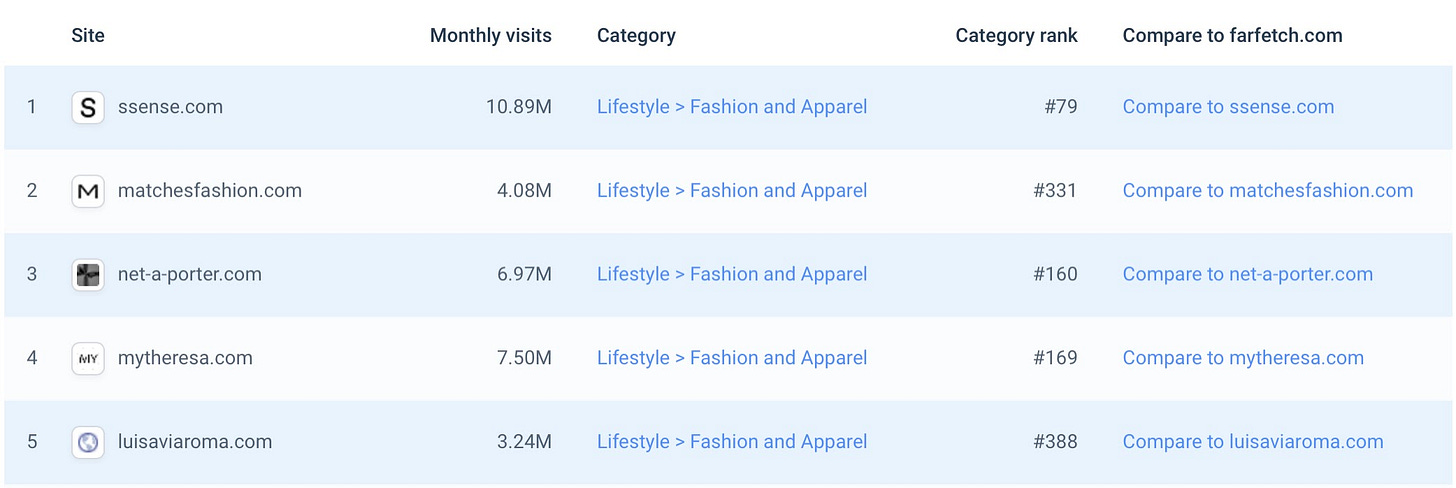
For a little bit of context, Farfetch has close to 30 million monthly visits of which more than half are organic. The key word here is “most” because there is one online luxury retailer that operates at a similar scale than Farfetch: Yoox Net-A-Porter.
Yoox Net-A-Porter (YNAP)
YNAP owns 4 multi-brand online marketplace: Yoox, Net A Porter, Mr. Porter and The Outnet. This last online marketplace should sound familiar because we already mentioned it in the management section as it was founded by Stephanie Phair, one of Farfetch’s top-tier managers. These 4 multi-brand online stores enjoy a combined 30 million monthly visits, approximately the same traffic as The Farfetch Marketplace.
YNAP, similar to Farfetch, is also much more than “just” a digital marketplace because in 2006 the company launched Online Flagship Stores, a B2B offering to help luxury brands power their e-commerce solutions. Sounds familiar? It should because it is really similar to Platform Solutions. This segment was launched by the company to execute on its vision of Next Era:
Its (Net-a-porter) advanced omnichannel model – NEXT ERA – blurs the lines between online shopping, mobility and the boutique, providing unprecedented visibility and access to products across the world, transforming the shopping journey for customers, wherever they are and however they choose to shop.
Source: YNAP
Sounds familiar too? It should! This is somewhat similar to Farfetch’s vision of Luxury New Retail.
YNAP was acquired by Richemont in 2018 which will help the company enjoy significant synergies due to the top brands Richemont owns such as Cartier, Mont Blanc and IWC:

Owning these brands will help Richemont in a similar way than owning brands help Farfetch:
Richemont will be able to drive organic traffic to YNAP online stores through brand exclusivity
YNAP will be able to execute on its Next Era vision through Richemont’s physical stores
This said, up to this moment, Richemont owned brands such as Cartier and Montblanc can be found on The Farfetch Marketplace whereas brands such as Off-White can’t be found on YNAP which might indicate that Richemont’s brands find more value on Farfetch than Farfetch does on Richemont’s marketplaces. Clearly Farfetch is already executing on exclusivity to drive organic traffic.
As YNAP is owned by Richemont, its numbers are reported with the latter’s as “online distributors” and here, the image is not that great:
YNAP saw sales decreased 9% during the pandemic year which is kind of worrying for an online retailer during a period when physical retail decreased drastically due to lockdown restrictions.
Looking at other key numbers such as active consumers and AOV (which we could only obtain for 2018 in the case of YNAP) we see that YNAP relies more on discounts to drive customers to its online marketplaces:
This might indicate that Farfetch’s brand awareness is higher than that of YNAP although take into account that these numbers are pre-Richemont acquisition so they might have improved post-synergies. This higher brand awareness can also be confirmed by Farfetch enjoying higher organic traffic to its marketplace than YNAP’s online marketplaces.
Speak volumes about Farfetch that is has been able to reach the same number of Active Consumers as YNAP had in 2018 while maintaining a stable Average Order Value above $600.
The fact that all of Farfetch’s competitors are relying on discounts to drive traffic is a double edge sword. On the negative side, it gives signs of an increasingly competitive price environment. On the positive side, the fact that Farfetch is growing strong its key metrics while operating in this competitive price environment while relying less on discounts speaks very positively about the company’s competitive position.
YNAP and Farfetch are almost twins if we only analyze their business models but they are not even closely related in terms of execution. Farfetch is executing flawlessly while staying in the high luxury niche while YNAP seems to be having more trouble executing in a not-so-high luxury environment.
The most ironical thing is that Richemont, owner of YNAP, has invested a significant amount of money in Farfetch.
Outside of the online luxury industry, in our opinion, there are two competitors that, even though they have not been successful in operating in this niche, can’t be underrated due to their massive scale: Amazon and Shopify.
Amazon
If we are talking about retail or e-commerce, Amazon has to be there. Jeff Bezos’ giant is a predator in every industry imaginable. The “Everything Store” wants to literally be the leader in everything, including luxury. José Neves seems to know that, as he talked about the competition with Amazon several times:
See, I'm a Prime subscriber, I buy everything there. But it's convenience, their own model is one of convenience, value and speed. Those are not the values of fashion, because it works on emotion. Nobody needs another bag, sandal or clothing. You buy fashion for the culture.
Amazon is not good at this. It is so true that players in specific categories, such as Chewy, in pet products, or Wayfair, in decoration, have had extraordinary success, fighting against the Amazon model, because they are aspiring businesses. They are of the same mindset as Farfetch, that nothing on the platform will harm the businesses housed there. Luxury is the extreme of it, it has an intangible value. And well, we are world leaders in this segment.
Neves' point does make sense (or else Amazon wouldn’t be struggling in fashion). As we saw, luxury is still an exclusive and focused industry, people want to feel the exclusivity of buying a high fashion item, not a quick scroll through an app and Amazon doesn’t deliver that in their main marketplace. Besides that, physical retail is very resilient in luxury, something that Amazon doesn’t want and Farfetch is embracing with LNR.
Although the famous take “Amazon is good at selling clothes not fashion” still stands today, that is not to say that it will forever. Amazon is making an effort to get into the industry and it’s not afraid to innovate to do it. Last year it launched Luxury Stores, much like the Chinese JD and Alibaba, providing a separate shop inside the marketplace with High Fashion items, buying experience and layouts (and promos for Prime members).
Although the launch is less than a year old, we can see through the imperfect Google Trends that it has not been that much of a success yet:
This is evidenced further by the brands that Amazon Luxury has been able to attract to their platform: Oscar de la Renta, Roland Mouret, La Perla, Altuzarra, Clé de Peau, Car Shoe, RéVive Skincare, Mark Cross, The Conservatory and Elie Saab, none of which can be considered a top brand in the luxury industry.
Take into account that even though Amazon is the e-commerce giant, Luxury Stores is only available for prime customers who receive an invitation, which lowers the reach for potential brands.
Nevertheless, you can never count Amazon and its endless innovation - and deep pockets - out of any retail sector. For now Farfetch has the headstart to build its moat but it’s worth watching closely how this battle evolves.
Shopify
We already mentioned in this article that Platform Solutions (FPS) can be compared to the services that Shopify provides in some way. While the objective of both Farfetch and Shopify is pretty much the same (facilitating e-commerce selling for its customers), the truth is that Farfetch’s offering is much more tailored towards luxury brands than that of Shopify.
As we have already mentioned, Luxury Brands want to exploit the biggest luxury market in the world: China. When trying to do so, they typically struggle because business is done different in this geography and you have to find the right strategy to achieve adequate traffic through the digital channels. Farfetch struggled with traffic a long time ago but through its partnership strategy has been able to increase traffic dramatically. What this means for potential FPS customers is that with Farfetch, they will obtain an adequate traffic almost instantly, something that Shopify can’t guarantee as of today in China.
Another strength that Farfetch has with respect to Shopify is its Luxury New Retail (LNR) strategy because it allows Luxury Brands to potentially connect both their physical and digital presence in any country. This, although it might seem anecdotal right now, is expected to become one of the key reasons why luxury brands might choose Farfetch over Shopify in the coming years.
Although it’s quite clear that Platform Solutions are more tailored towards Luxury Brands than Shopify’s offering, it’s always important to keep a close eye to competition, especially when it comes from high quality companies such as Shopify.
Farfetch is still a company that is enjoying quite substantial growth even though it has already reached an impressive scale. This is a very positive indicator of the company’s competitive position in the industry because even though its market TAM welcomes increased competition, this has not impacted the growth of the company and its take rates, at least to this day.
8. VALUATION
To talk about valuation in our deep dives we will always try to use two methods to value companies: the discounted cash flow method and comparable ratios through multiples. This time however, we decided to talk only about ratios…but we have a good reason for it.
Discounted Cash Flow
Unfortunately DCFs is an inexact tool, highly based on unknown premises and too dependent on personal beliefs. This is true for every company because it is very difficult to predict the future but in the case of Farfetch, we couldn’t even do a well thought out prediction.
Due to the extremely unpredictable margin structure, not much transparency on revenue sources and an unsustainable take rate; the model would be more a personal opinion from us than a helpful valuation. Because of that we decided to skip the DCF model for this one and focus on the other valuation methods herein presented.
Most of our future DDs will contain this valuation, so don’t worry.
Multiples
Over the last few months, Farfetch has seen its stock price decline significantly, currently trading close to 45% off highs:
This stock price decline, coupled with increasing revenue and gross profit has had the effect of contracting the EV/Revenue ratio even faster than the stock price:
However, we should consider other ratios for Farfetch. Considering that gross profit margins are under 50%, comparing EV to GP paints a clearer picture. With a current enterprise value of $14.37 billion and $909.1 million in TTM Gross profit, the company currently trades at a TTM EV/GP ratio of 15.8x.
Lastly, FarFetch has a Rev/S&M multiple of 8.35. This means that for each dollar of S&M spent they get back 8.35. This number is not bad, but it’s not perfect. Shopify for example has a 5x multiple, worse than FTCH, but Amazon is up there on a 18x one.
The difficult question is…what multiple is adequate for Farfetch? Should we value it as a pure tech company or should we value it as a retailer? Maybe a hybrid? This question has no correct answer and everyone might see it differently which is why we decided to directly compare it to the company that we thought was the most comparable: Yoox net a porter.
As YNAP is not currently publicly traded we have to use the acquisition price of Richemont to draw our conclusions. Richemont bought YNAP for approximately $6 billion when the company was growing its top line by less than 1% Y/Y at the time of acquisition. In 2017, YNAP was trading at 10.2x P/GP with 28% gross margins. Due to its higher growth and gross margin we think that Farfetch deserves a higher multiple than YNAP which leads us to believe that the company is fairly valued as of today.
If you are liking this article, consider subscribing!
9. BULL CASE
In this section, we will try to provide some reasons why we think that Farfetch might be a worthwhile investment.
Management
When talking about investing in the future of any company, management should always be at the core of the investment thesis, more so if the company is still early into its growth. Farfetch is no exception and we think that the management team is exceptional and tailored perfectly towards the luxury industry and the objectives of the company.
Being founder-led is always an important characteristic of any company, more so if the founder retains a big stake and significant voting power. This is exactly the case of José Neves who founded the company almost 14 years ago and still retains over 70% of the voting power. We see Neves as a visionary who, aided by his mixed business and tech profile, is perfectly positioned to execute on the Luxury New Retail vision of the company.
There is a reason Warren Buffet third pillar for an investment is a great management. Some not so strong financials or not yet built moats can be accepted if they come with management great enough to solve and leverage a business with potential. Farfetch has that and we cannot put a price on it, just like so many Wall Street analysts couldn’t put a price on Jeff Bezos, just to see AWS and Amazon thrive years after.
Any investor or potential investor in the company must be aware that he/she is basically investing in José Neves - and his capable team - and we think that this means being in good hands.
The Farfetch Marketplace enjoys two-sided network dynamics
In the Farfetch Marketplace, both buyers and sellers show up expecting the other party to be present and, as the marketplace scales, both of these players show up in increasing numbers and power the flywheel.
More buyers means that more sellers will want to sell on the marketplace because they can do so over a larger audience. On the other hand, more sellers means that more buyers will turn up because they have a wider variety of options where to choose from. The flywheel looks like this:
Even though this flywheel might seem too simple or to lame to be true, this is a very powerful effect which has helped grow other marketplaces such as Airbnb and Amazon. Of course, the key to sustain the effects of these flywheels is the alignment inside the marketplace between both buyers and sellers.
Current scale and Luxury New Retail for the future
Fashion can’t be seen as a unique homogeneous industry because there are many niches embedded in the fashion industry. Luxury is probably the most famous niche inside fashion and it has proven to be a highly complex one to penetrate for e-commerce giants such as Amazon and Alibaba. There are, of course, smaller more tailored e-commerce players that have managed to operate inside this niche some of which were outlined in the competition section of this article.
However, Farfetch is one of the few players that has managed to obtain a considerable scale inside the luxury niche aided by Neves’ obsession in bringing the highest quality brands to the platform to attract more active customers. This scale, however, might turn out to be insufficient to stop competitors from eating the company’s lunch in the future. This is where LNR comes into play, to protect the company’s competitive advantage going forward.
Neves and the rest of the management team have decided to center the vision around a hybrid digital and physical offering which aims to satisfy the wants of any luxury customer: going to a store to enjoy the luxury experience while being able to enjoy the benefits of online shopping. This offering stands in the intersection between Platform Solutions and the Store of the future and only time will tell how successful it is across luxury brands.
Untapped potential in e-commerce luxury shopping
Farfetch is the indisputable luxury e-commerce leader and the industry’s shift towards online shopping is just getting started. Online luxury shopping is expected to grow at a 23% CAGR until 2025 when online luxury sales will make 30% of total luxury sales. This shift will be aided by a shift to the new generations with Gen Z estimated to make 70% of total buyers, up from 44% in 2019.
If Farfetch is able to maintain its market share then it will grow at this estimated 23% for the next 4 years but we believe that it will in fact increase its market share due to its two-sided network dynamics and the current inability of big players to penetrate the luxury industry. For this reason, we expect Farfetch to grow at +30% rates for the next 4 years at least and believe it will be able to maintain similar growth rates after these 4 years as Platform Solutions will probably start to contribute significantly to revenue.
Partnerships and Trust From Brands Create a Moat
In fashion, as we’ve seen, trust between brands/boutiques - from the smallest to the biggest ones - and the marketplace is pivotal, even more than in standard e-commerce. José Neves leveraged his knowledge and soft skills early on in his career and has built a network of trust for Farfetch with small boutiques.
Like he said, fashion is “more emotional and sensible” than what we see in common retail. Boutiques and Brands, run in the same family for years are over protectionist of what they sell and especially where they sell. As the already quoted Carmen Busquets said:
If it hadn’t been for Farfetch, many of our favorite local boutiques would have disappeared.
That itself is a bull thesis. It represents a moat difficult to be surpassed by a huge competitor. It’s improbable that an Amazon with its hundreds of areas and specialities will build an intimate relation with these hard to convince small brands, so getting them out of Farfetch is a distant possibility.
Although this kind of moat is difficult to value, we can’t ignore the strong presence it has and the important role it will play in the future of the company.
Luxury is very resilient in crises
There is a key characteristic of investable companies that many investors tend to overlook: resiliency. Investing in “young” companies is great because you get to enjoy more potential upside but it’s also more dangerous than investing in already established companies because they tend to be more fragile during recessionary periods.
In our opinion, Farfetch has two key characteristics that make it resilient. Firstly, the company survived the 2008 financial crisis when it had just been created two months ago and this resilient character was integrated early on in the company’s culture. Secondly, the company operates in a very resilient industry: luxury. This industry also suffers during recessionary periods but tends to recover quickly:
The financial crisis of 2008 had the effect of concentrating the industry among quality companies such as Gucci, LVMH and Richemont which saw flat or increasing sales growth during this period.
10. BEAR CASE
In this section of the article we will go over what we think are the weak spots of the company as an investment opportunity.
Lack of transparency in the numbers
As we saw at the beginning of the article, even though Farfetch has six business lines, it bundles parts of these lines together under three operating segments: digital platform, brand platform and in-store. Although we can get a good feel of how the brand platform segment and the in-store segment are doing, this becomes a very difficult task when it comes to digital platform.
All of the 6 business lines are included in some way or another in the Digital Platform segment but they are not reported separately which makes it almost impossible to analyze how important businesses such as FPS and The Store of the Future are doing. These two business lines, as discussed above, will probably play a key role in the future of Farfetch but investors are not getting the full transparency of these numbers.
Luxury Role in China’s Future
China can either be a huge bullish driver for Farfetch or the center for a bear case. As previously discussed, China’s middle class will likely double in the next decade, disposable income will surge and an even bigger consumer cohort will be created. That will maintain China as the main responsible for luxury growth for many years to come.
All of that would sound perfect if we didn’t already know how China operates. Any investor has to know that companies exposed to China or Chinese dance in different music from the majority of the rest of the world. The point is, the Chinese government - as many times stated - doesn’t want to create a consumerist population or capital accumulation as an end goal.
With that in mind it’s obvious that the CCP doesn't exactly approve spending tens of thousands of dollars in purses and sneakers. Now that does not exactly mean that China will kick out Farfetch like it did with Facebook or Google, these extreme measures are possible but we don’t have any clear sign if it’s probable.
However, that doesn’t mean that China cannot apply measures - directly or indirectly - to decentivize the over spending on luxury. We’ve seen that with the gaming industry, we are seeing the start of that with social media and nothing stops that it might happen with luxury.
It is fair to say that China is unpredictable and Farfetch's excellent management is already thinking of ways to face this probability. Even so, we have to consider that losing the totality or some of the most important market for the next decade is a bear case to be watched closely and try to reflect this probability on the valuation.
Margin Structure and Take Rate Sustainability
Profitability is not a must when a company is growing fast but it is always a nice to have. Farfetch seems to be far away from profitability, especially considering the high SBC the company is incurring.
Another question we should ask ourselves is: will the company be able to sustain 30% take rates in the distant future? Up to now, Farfetch has done a pretty good job in sustaining its take rate high, aided by the fact that nobody operates at its scale but this high take rate warrants intense competition, especially by companies already operating in the luxury industry.
However, with competitors lurking, will Farfetch be able to build optionality before a challengers arises? Or does it think the take rate is sustainable? These questions are pivotal for the margins structure to improve and then most importantly settle. That will take time, but needs to be watched closely.
Competition
Although we outlined in the competition section that Farfetch is well protected against competitors, competition is always a risk, especially in such a fast growing industry as the online luxury market. Moves by giants such as Amazon are worth monitoring going forward and take rates and GMV growth are a great way to analyze if these competitive pressures are affecting the company.
Besides that, with the new trends in luxury and the move to digital the probability of new incumbent companies arising and challenging FTCH increases by the day. This might come from any part of the world, including China, where the startup ground is evolving rapdly. Also consolidated players like JD are already making moves and closing parnterships with the likes of LVMH.
Always take into account that there will always be intense competition in highly profitable markets. This is just how capitalism works.
11. FINAL THOUGHTS
As this is the first combined research we do, we wanted to share our final thoughts in a special way. Each one of us is going to share his thoughts on the company individually and will outline his plan with Farfetch as an investment opportunity.
B&H
Farfetch doesn’t have the best financials but this doesn’t mean the case is not worth a bet. With one of the least flawed management teams I’ve seen lately and a monster runaway, I think the company deserves a shot at the right price.
Waiting for the China situation, although is important to monitor, is not an option. We don’t know when or if the risk will eve materialize, so buying uncertainty is a sure thing on this one.
However, due to my strategy of high concentration, the names I own are currently on a price where I prefer to keep adding instead of including a new name. When the day to include a new name comes, Farfetch will be high up the list for my decision
IQ
I think Farfetch is a great company led by extraordinary management. Although I currently have no exposure to the luxury industry I will not be investing in Farfetch after doing this research for the following reasons:
I think the company is great and the opportunity ahead is significant but China poses an important risk to consumeristic behaviour where industries such as luxury belong
I currently hold 19 positions and want to reduce this number to approximately 10-12 to be able to closely track all of my holdings. This means that if I want to add any new position it must be a top-10 conviction for me. I don’t think that Farfetch will achieve this, unless I can get more transparency in the numbers of FPS.
I will of course watchlist Farfetch in case I decide to revisit it in the future.
We really hope you enjoyed this deep dive and we would love to have you around when we publish our next one!
Stay well!
B&H and IQ













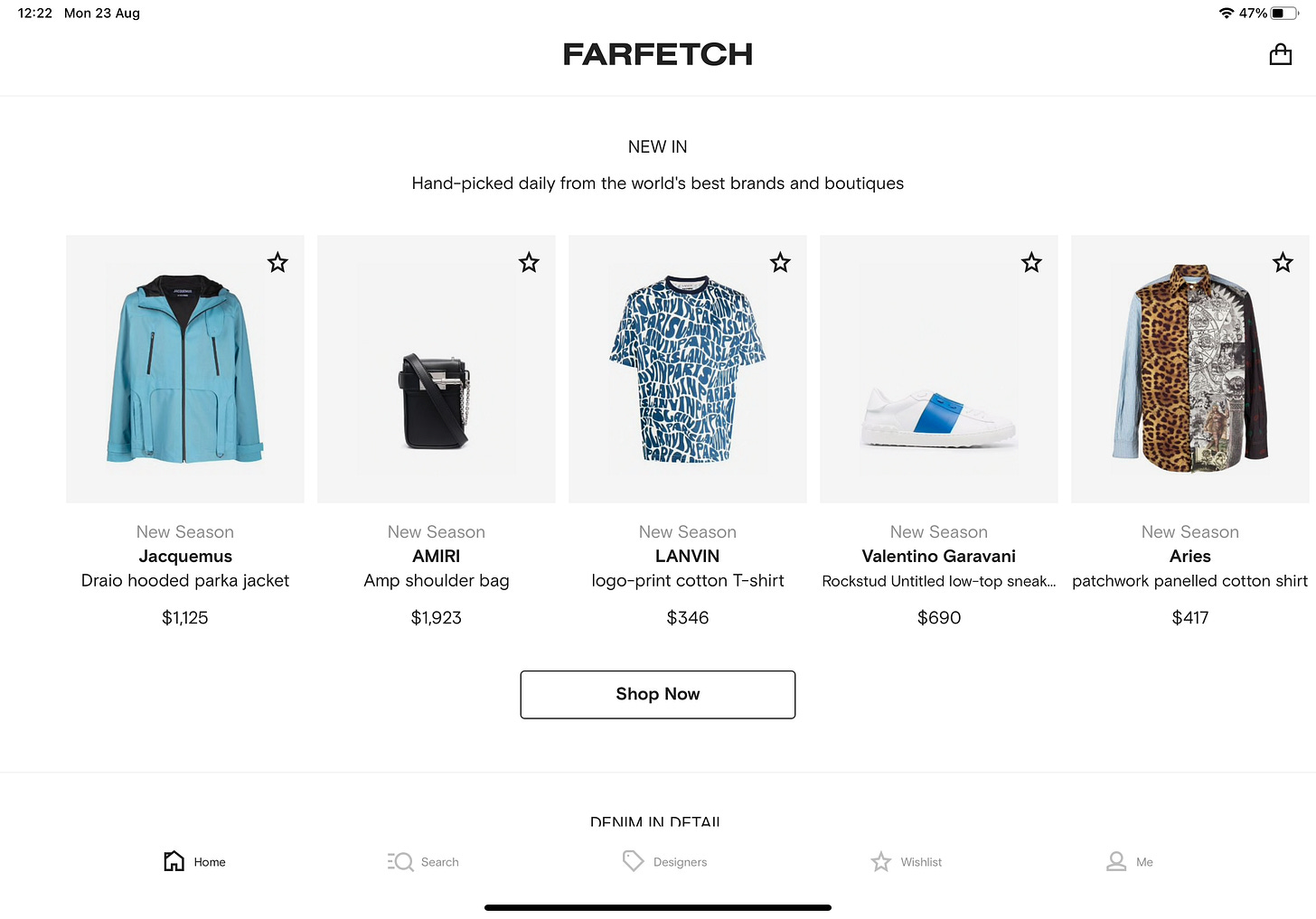






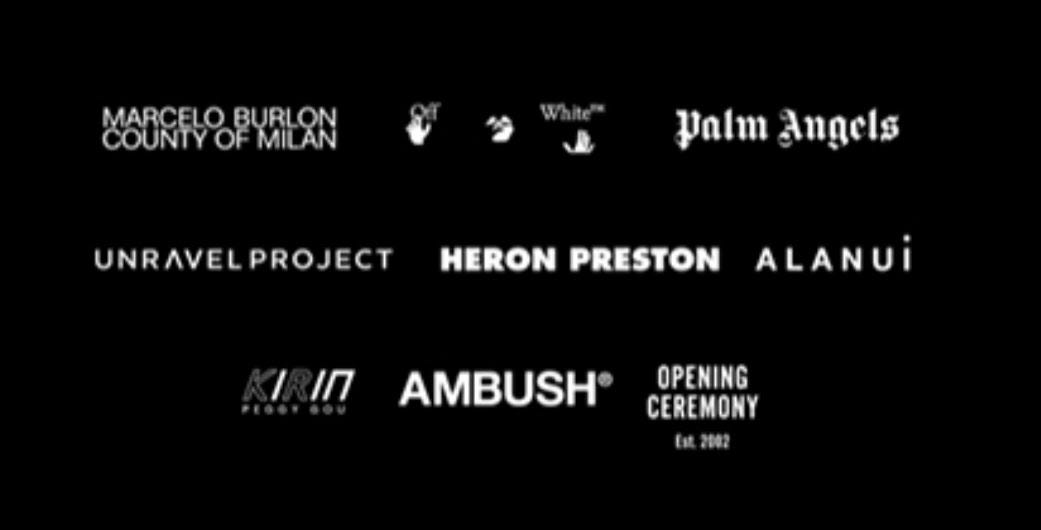


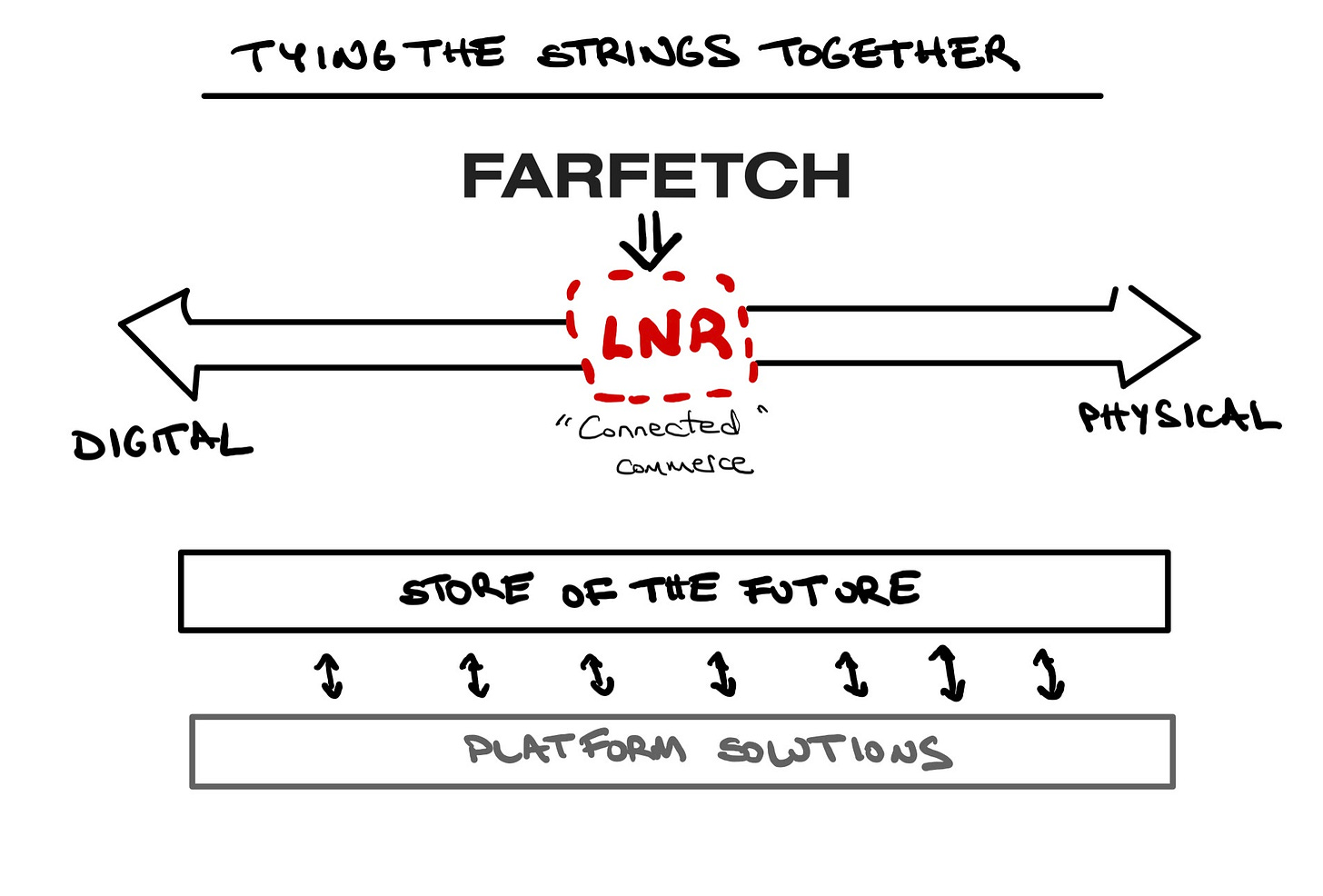


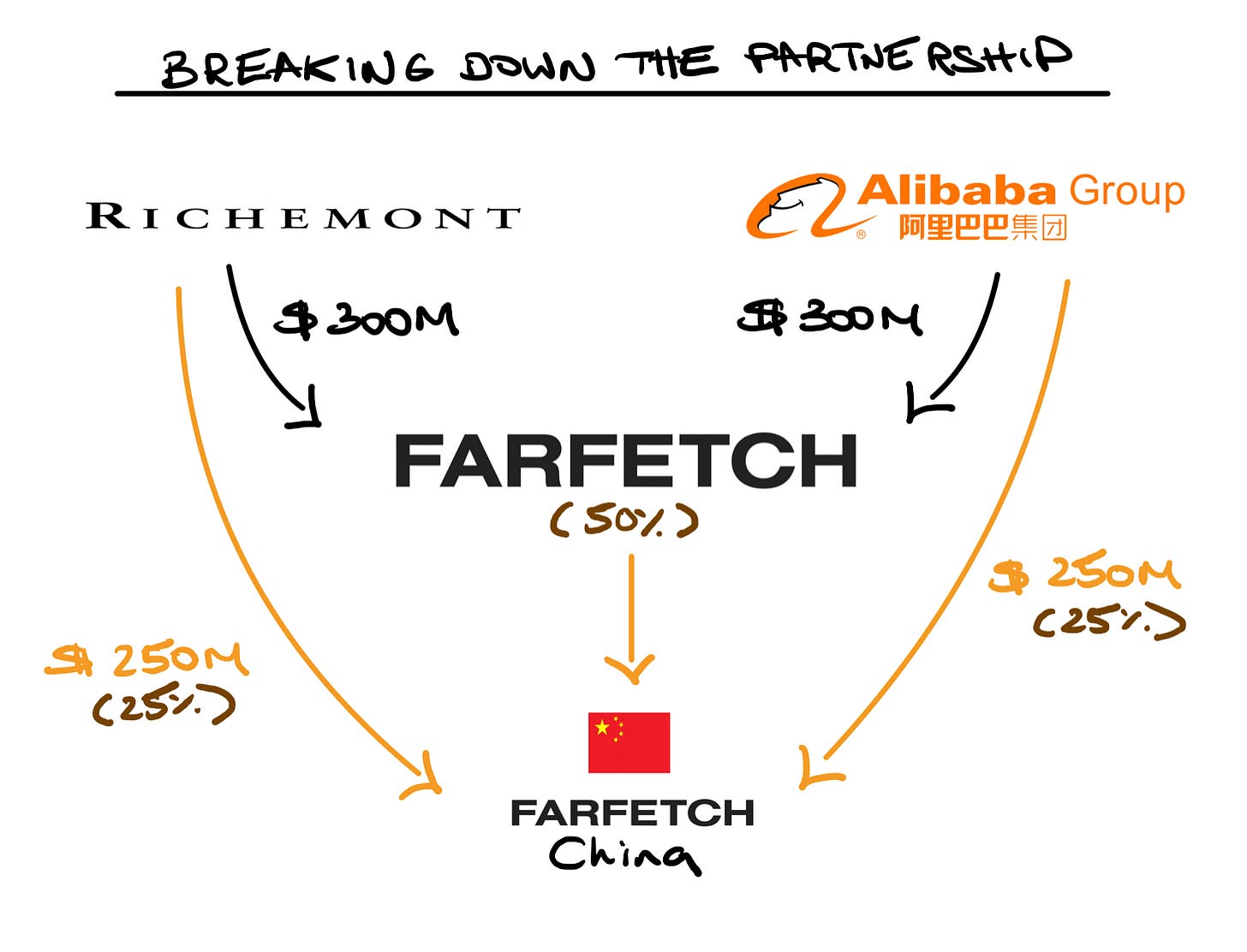
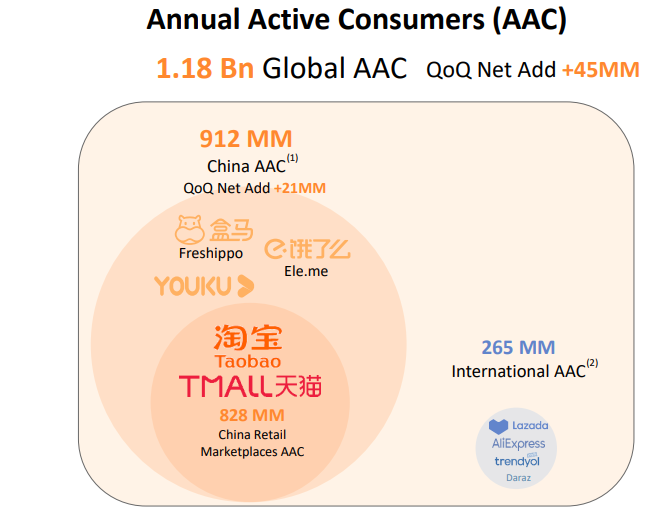











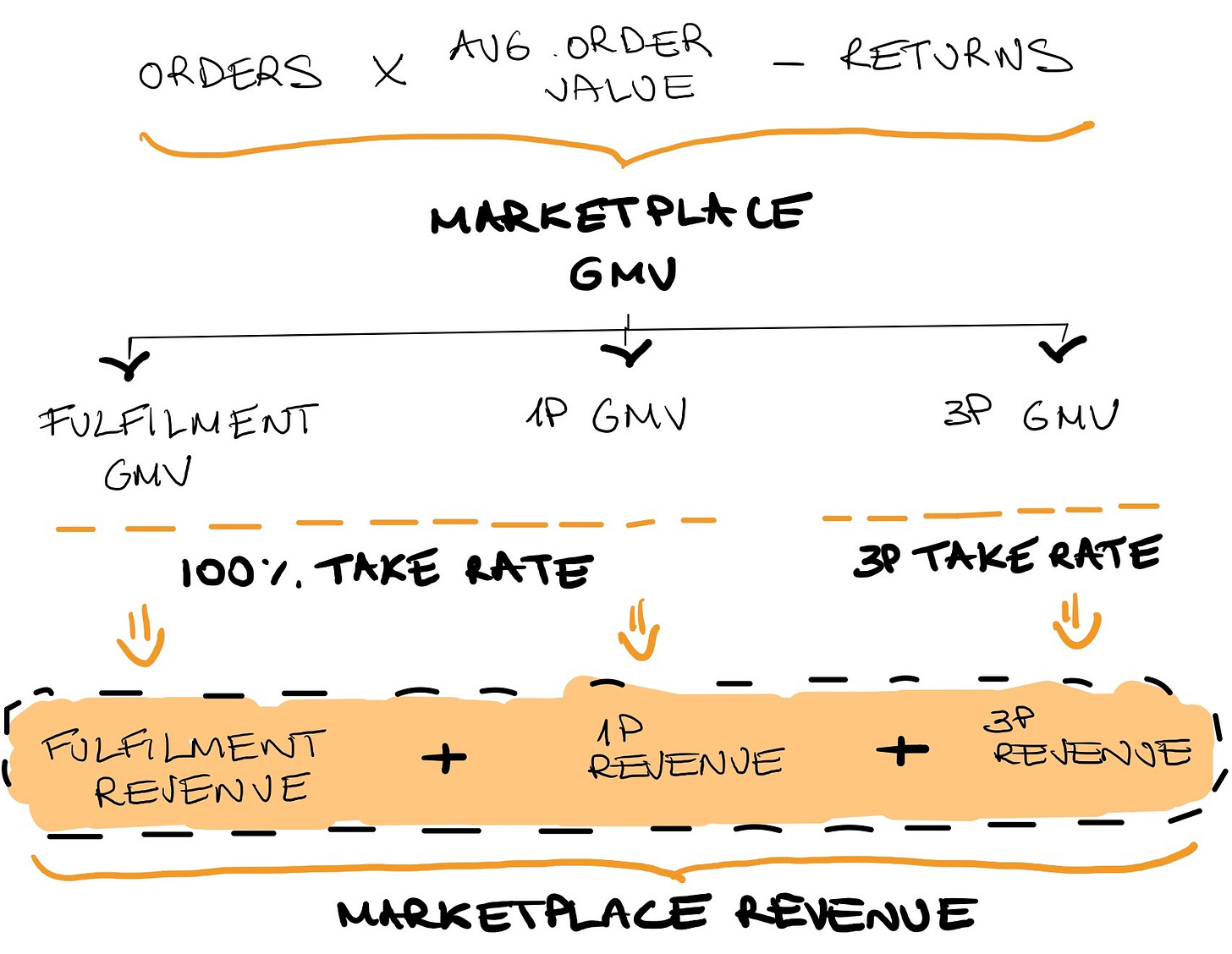






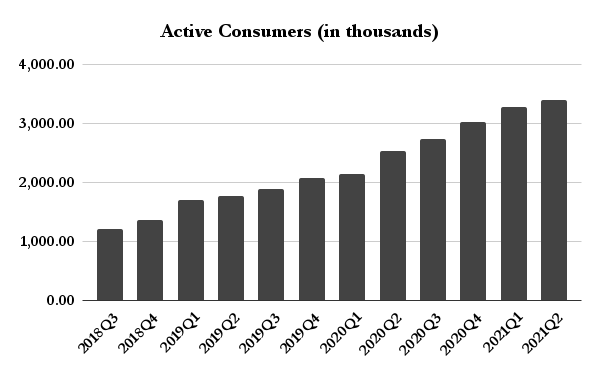



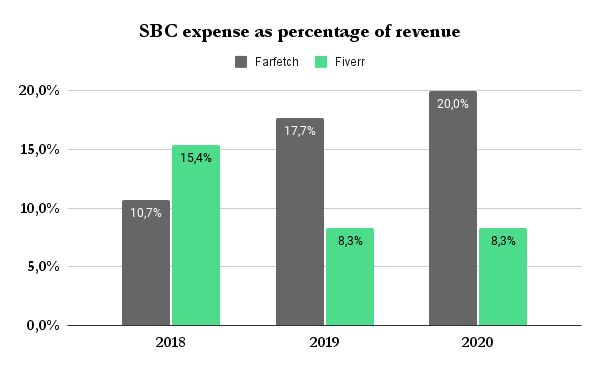















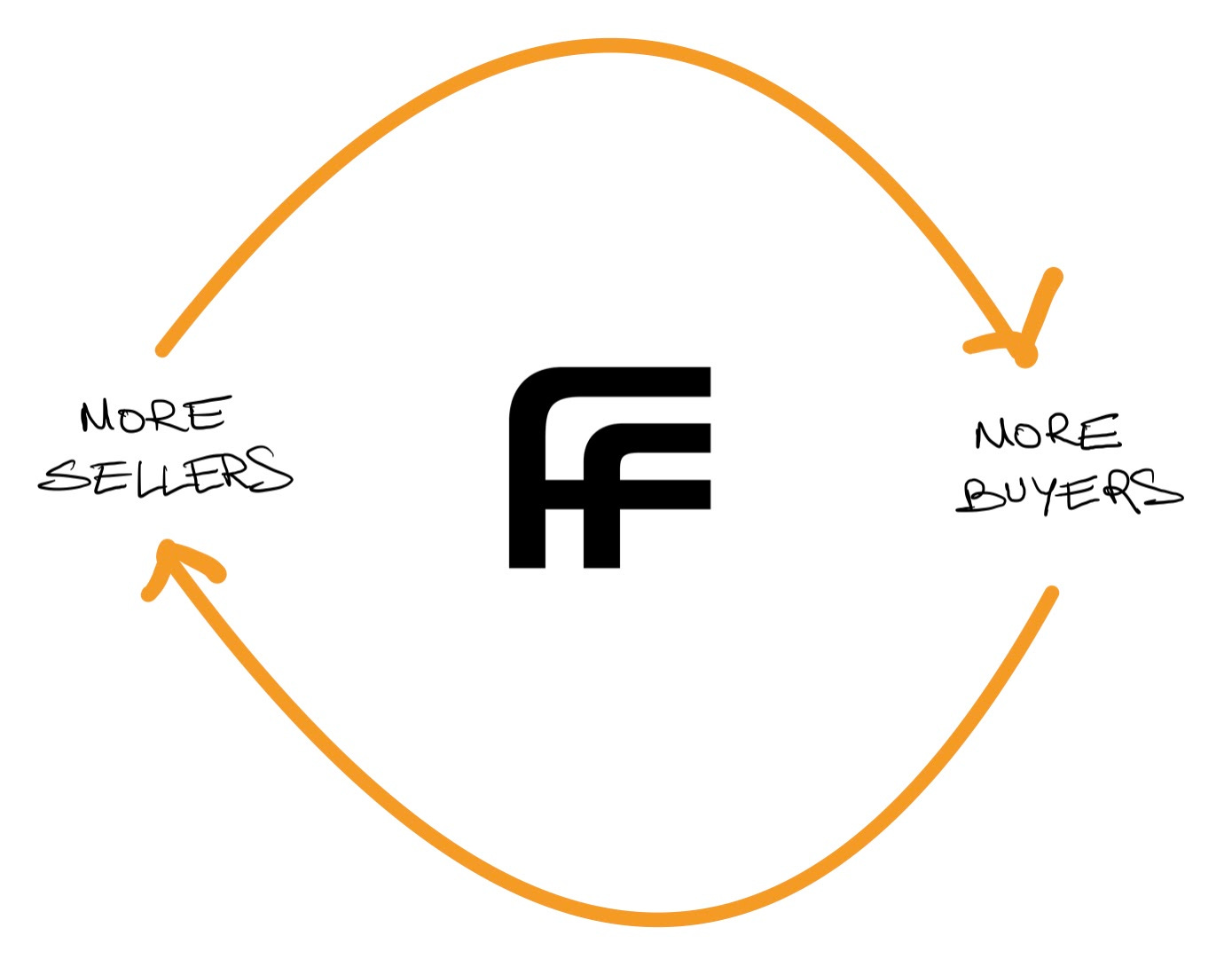
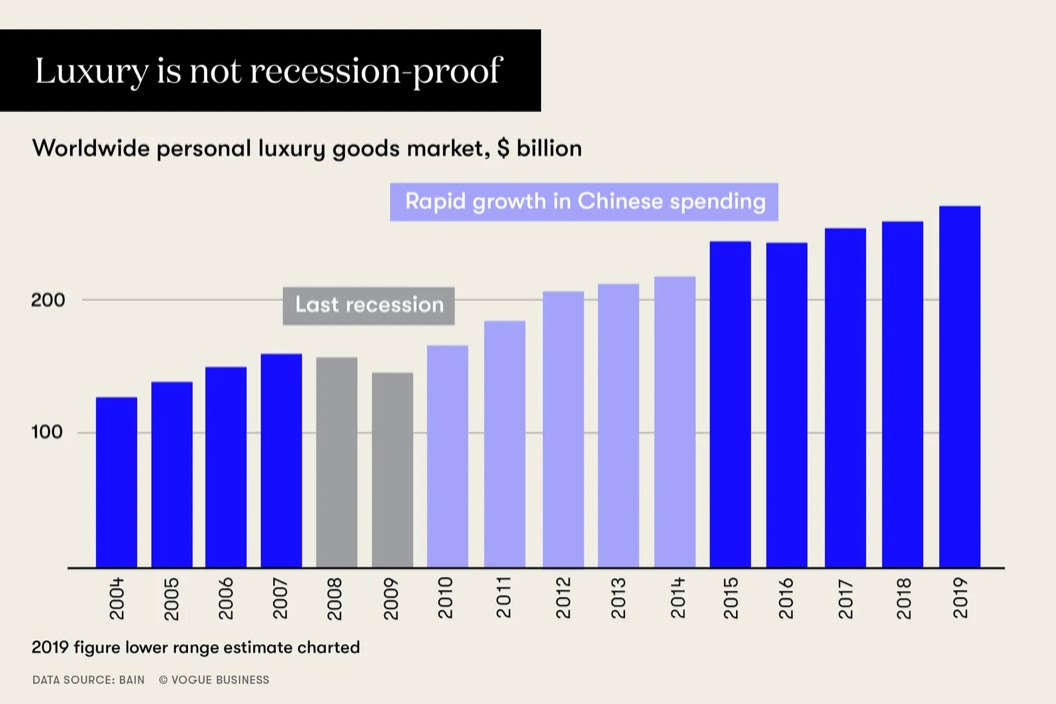



Thanks for the piece guys. Great work!
Very detailed DD. Many thanks.